COMMEMORATION
It is with great sadness that I relay the news of the death of Edward (Ed) Chaplin who passed away at home on 21st April 2016. He is survived by his wife Christina and two sons Jeremy and Robin, and Granchildren Katie, Jonathan and Chelsea. Born in London in 1940, Ed was just 2 years-old when his family moved to Surrey to escape the London Blitz. His interest in all things 'Great Western' began as a small boy during family trips by steam train from Paddington to visit his grandparents in Gloucester. Some years later he joined the Great Western Society and regularly attended their open days. Then in 1981 he started collecting postcards of WR main line steam, many purchased from John Smith, proprietor of Lens of Sutton on Westmead Road, then a Mecca for serious students of transport.
Born in London in 1940, Ed was just 2 years-old when his family moved to Surrey to escape the London Blitz. His interest in all things 'Great Western' began as a small boy during family trips by steam train from Paddington to visit his grandparents in Gloucester. Some years later he joined the Great Western Society and regularly attended their open days. Then in 1981 he started collecting postcards of WR main line steam, many purchased from John Smith, proprietor of Lens of Sutton on Westmead Road, then a Mecca for serious students of transport.
Over the years, Ed's contribution to the hobby has been quite remarkable; not only has he generously helped me and other contributors with the creation of this website, he was meticulous in acknowledging those who assisted in his own research. Above all else, his willingness to share his in-depth studies with others is an admirable quality and many enthusiasts have dropped a line to express their appreciation.
During the time we have worked together, I learned so much from him…in particular Ed's dedication and enthusiasm taught me that great things can be accomplished in life when you care little about who gets the credit.
Few men have made such a lasting impression.
Thanks Ed and rest in peace.
You will be greatly missed…
INTRODUCTION BY DAVID HEY
The level of support this website receives from fellow railway enthusiasts is extraordinary. The Internet is a valuable resource visited every day by countless thousands of enthusiasts, all of whom have their own diverse interests and varying expertise, including a number of scholars who might analyze a subject right down to the smallest detail.  Fair enough, the ins-and-outs of railway operation is a fascinating subject and it is important to get the facts right which is why I am always grateful to visitors who've kindly corrected errors on these pages and offered good advice.
Fair enough, the ins-and-outs of railway operation is a fascinating subject and it is important to get the facts right which is why I am always grateful to visitors who've kindly corrected errors on these pages and offered good advice.
(Inset right) Derek Dean writes an evocative caption for this Stuart Sanders photograph: 'The fantastic sight and sounds of a beautifully-clean Britannia starting away from Paddington Station was an experience to be savoured; the 'Red Dragon' express restaurant service to Carmarthen begins its long journey hauled by 7MT Britannia No 70016 Ariel of Cardiff Canton depot, where the staff looked after their BR Standard Pacifics extremely well. When the staccato exhaust hit the underside of Westbourne Bridge, the reverberations could be heard and felt by all those within earshot; wonderful memories, wonderful times…' More can be found on Derek's Britannia Class 7MT Page 91 (see left-hand menu).
Indeed visitors to this site can be broken down into three main categories: the person researching a particular project, the person looking for an old-fashioned nostalgic wallow or the hardcore railway buff who is interested in every minute detail of every permutation of every aspect of railways; the kind who'll surf the site for days on end and probably not care where they end up!  (Left-Below) It is said that a picture on its own is worth a thousand words, but the converse can also be true as I hope you'll find when going through the pages on this site. However, when you look at the economical wording in some of the Western Region captions, you'll understand why I think Ed's research into the Western Region's Reporting Numbers is so significant.
(Left-Below) It is said that a picture on its own is worth a thousand words, but the converse can also be true as I hope you'll find when going through the pages on this site. However, when you look at the economical wording in some of the Western Region captions, you'll understand why I think Ed's research into the Western Region's Reporting Numbers is so significant.
Those confounding train numbers have dumfounded me for years!
For example, this splendid shot by Richard Greenwood is simply described as a single-chimney 'Castle' class No 4075 Cardiff Castle heading an 'up' express at Twyford on Saturday 29th July 1961. Okay, it is hardly an edifying caption, but when in doubt the less said the better.
Ed writes: The A49 headcode indicates the 10.42 SO Weston - Paddington.
Similarly Richard Greenwood's shot (below) of Castle class 5060 Sarum Castle in charge of what appears to be an inter-Regional train for the LM Region was taken at Leamington Spa on Easter Tuesday 1962.
Ed writes: In 1960, M13 was the 0933 SX, 0930 SO Bournemouth West - Birkenhead, WR loco on at Oxford.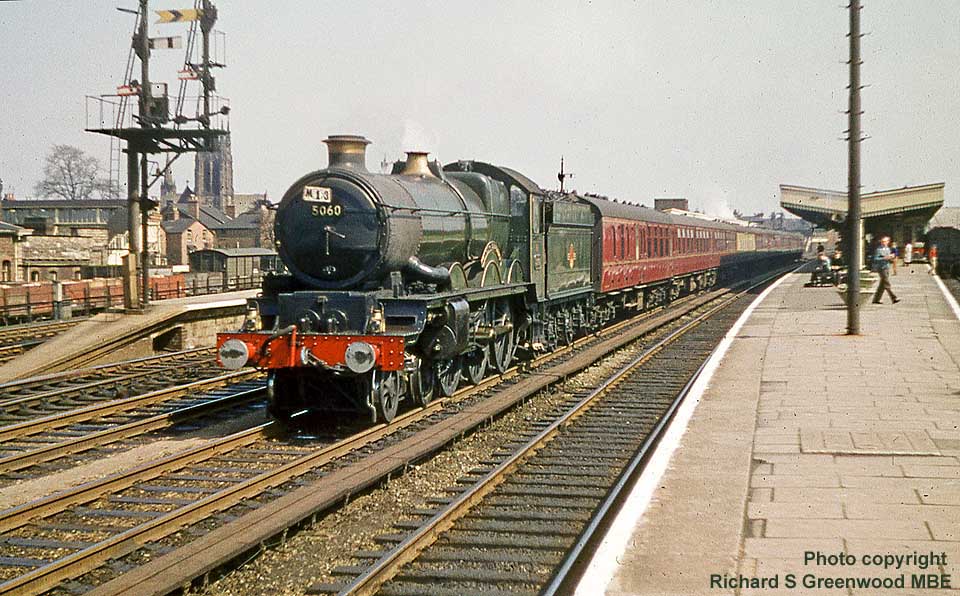
However in an odd sort of way this wonderful support from contributors has led to some confusion; over the years the domain name 'David Hey's Collection' has become something of a misnomer, at worst misleading. It implies that the content of the site belongs to me...IT DOESN'T!
Worse still, because my name is at the top of every page I risk delivering a snub to everyone involved by seemingly claiming it as my own work. I'M NOT! This brings me to the meticulous research by Ed Chaplin who has spent many years compiling a whole raft of information on the BR Western Region's reporting numbers.
This brings me to the meticulous research by Ed Chaplin who has spent many years compiling a whole raft of information on the BR Western Region's reporting numbers.
Well, like many others, I suspect, the configuration of the WR's numerals on smokebox doors were something of an enigma; we knew what they meant, of course, but due to the high number of different codes for different workings the true identity of certain trains always remained a mystery. So I asked Ed if he would be willing to pass on the findings of his studies for the benefit of site visitors, and I am delighted he kindly agreed.
He writes - 'David, it is a worthwhile task and I shall enjoy getting more to grips with it. The system was fairly steady until the winter of 1958 when wholesale revision occurred; then again in 1959 another round of revisions took place. However, at the beginning of the page I do need to add some overall provisos in, as some lists are not complete and might, despite considerable effort, contain errors and missing details. I do not mind if visitors are asked to offer corrections and additions; I do not have a crippling pride, my purpose  has always been to get the thing right for myself, and I well know that out there are a lot of very knowledgeable enthusiasts who visit your site, and so it would be great if their knowledge could be shared with others…'
has always been to get the thing right for myself, and I well know that out there are a lot of very knowledgeable enthusiasts who visit your site, and so it would be great if their knowledge could be shared with others…'
(Left) Ed's humbling words sums up the spirit of the World Wide Web perfectly and I am proud to feature his work on this page. However, such is the complexity of publishing a list of Train Reporting Numbers on the web that it was decided to split them into individual years and create a PDF for each year. There is a good reason for this...a free PDF reader is relatively simple to download from the web, and a PDF is easy to view. Chances are you already have one downloaded on your machine. For example, if you click-on the arrow image (left) it will link you to downloadable PDF containing a full list of GWR Reporting Numbers for the year 1939. You will find a number of similar arrow images further down the page. These will link you to the Reporting Numbers used by the Western Region after nationalisation.  On a final note, it is inevitable that some lists will require updating from time to time. These revisions may involve replacing the whole PDF or adding a note to the page in which case a small graphic (inset right) will appear. Meanwhile, if you spot any inaccuracies, a contact email address can be found at the bottom of the webpage.
On a final note, it is inevitable that some lists will require updating from time to time. These revisions may involve replacing the whole PDF or adding a note to the page in which case a small graphic (inset right) will appear. Meanwhile, if you spot any inaccuracies, a contact email address can be found at the bottom of the webpage.
(Above) Following a Heavy General overhaul at the Swindon factory in October 1956, Laira's 'King' class No 6026 King John makes a splendid sight departing London Paddington with the down 'Cornish Riviera Limited'. It is little recognised that the Cornish Riviera was known to railwaymen as 'The Limited', yet the train carried a 'Cornish Riviera Express' headboard for most years. However from the summer of 1956 until 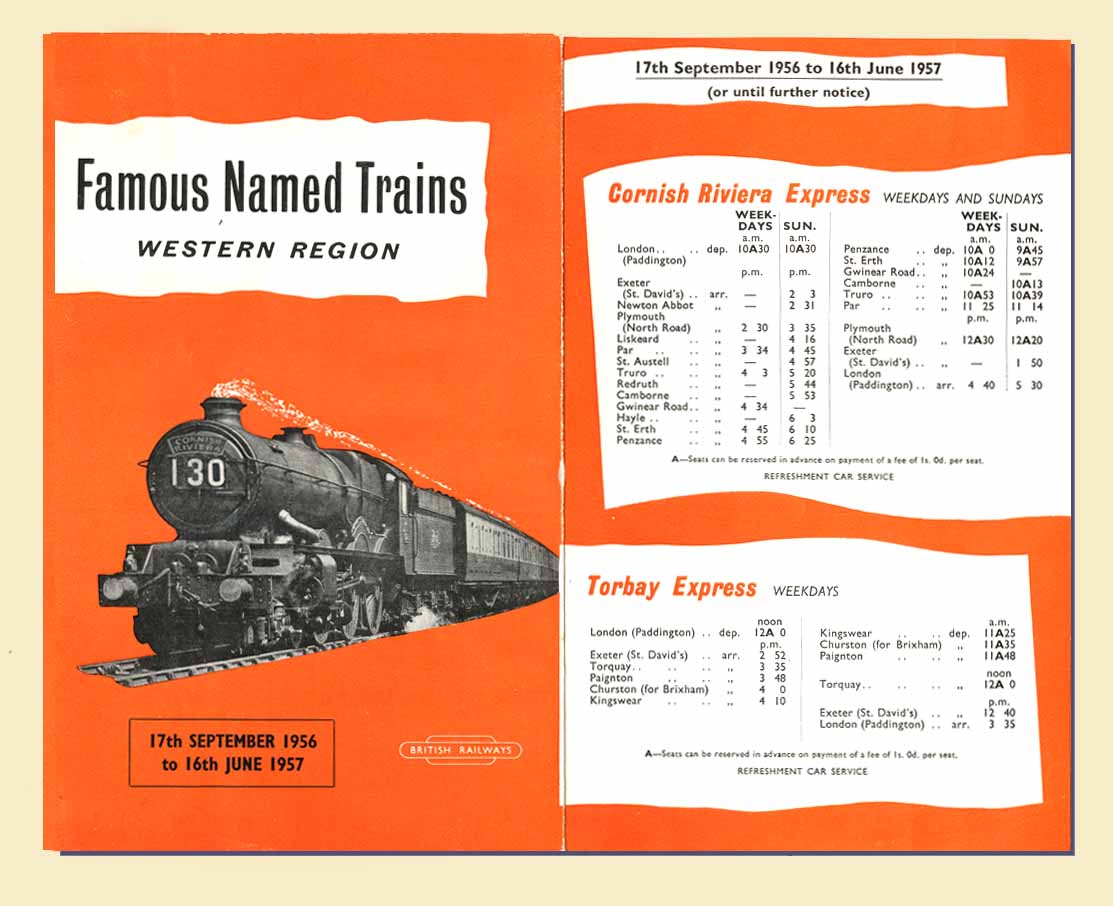 1st January 1959 the headboard included 'Limited' not 'Express' in the title, to which it then reverted; strange! To confuse matters even further, in 1934 the reporting number for the down 'Cornish Riviera' began with 125, later revised to 141 in 1939, then 160 in 1949, 130 in 1951, 133 in 1958, 416 as from 11 September 1958 and 426 from 14 June 1959…all in all, quite a performance!
1st January 1959 the headboard included 'Limited' not 'Express' in the title, to which it then reverted; strange! To confuse matters even further, in 1934 the reporting number for the down 'Cornish Riviera' began with 125, later revised to 141 in 1939, then 160 in 1949, 130 in 1951, 133 in 1958, 416 as from 11 September 1958 and 426 from 14 June 1959…all in all, quite a performance!
(Insets) The cover of this WR leaflet (17 September 1956 to 16 June 1957) features a 'King' class with train number 130 and 'Cornish Riviera' headboard, and inside can be found the timetable details of twelve named trains which will be featured on this page.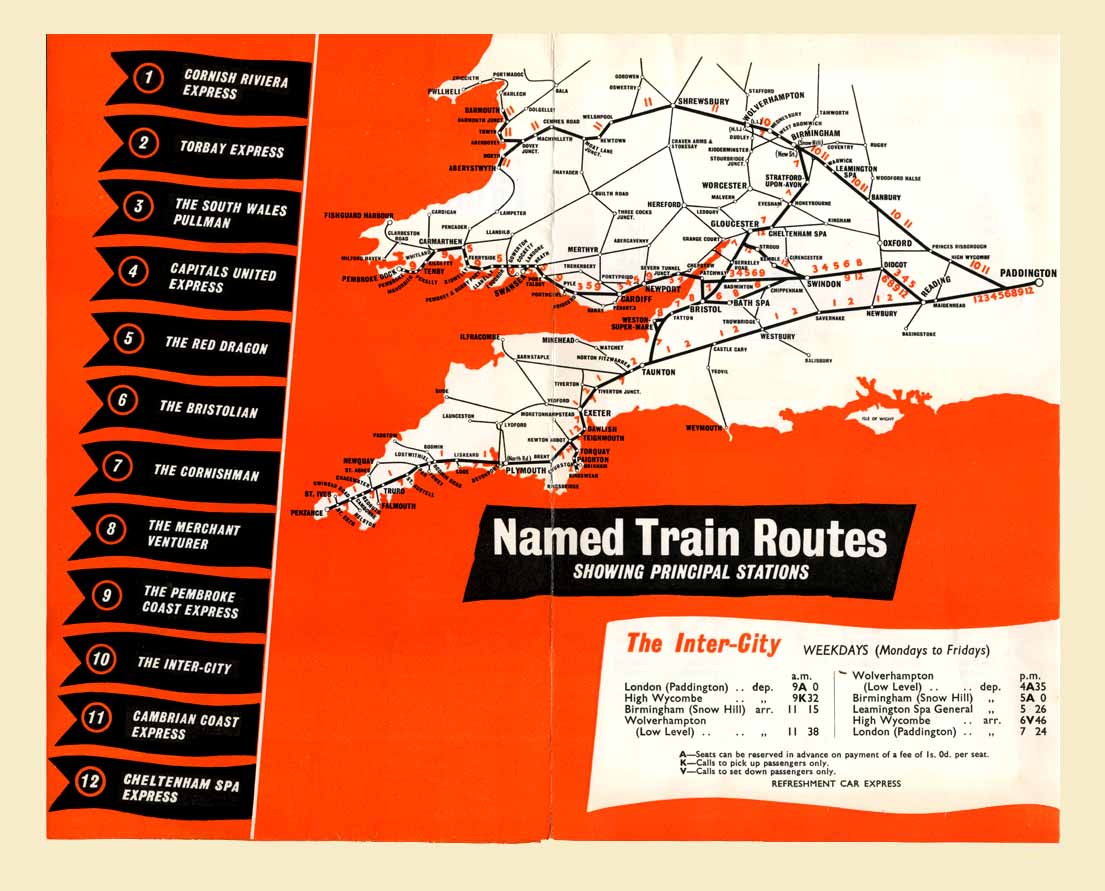 (Below) Finally, before handing over to Ed, I mention elsewhere on the site that accuracy is one of the most important parts of our hobby, though this is easier said than done. The memories we have of events that happened fifty or sixty-odd years ago can evaporate into thin air, especially when it comes to remembering dates.
(Below) Finally, before handing over to Ed, I mention elsewhere on the site that accuracy is one of the most important parts of our hobby, though this is easier said than done. The memories we have of events that happened fifty or sixty-odd years ago can evaporate into thin air, especially when it comes to remembering dates.
For example, the date attributed to Stuarts Sanders evocative shot of 'Castle' class No 5044 Earl of Dunraven departing Paddington with the 5.55pm down 'Red Dragon' is stated to be 4 April 1957.
Ed writes - David, I fear the date given is questionable. According to the 2014 reprint of 'The Book of the Castles' published by Irwell Press, No 5044 ran with a Churchward 3500 gallon tender from 14 February 1956 until 2 November 1957 when it acquired a 4000 gallon Hawksworth tender (as seen in Stuart's photo). The loco retained this tender until 28 November 1957 when it entered Swindon Works for a Heavy Intermediate overhaul, exiting with a Collett 4000 gallon tender.
A further explanation is that No 5044 was an Old Oak Common (81A) engine, and as both the up and down 'Red Dragon' services were Cardiff Canton duties, typically 'Britannia' Pacifics at that time, this leads me to believe that No 5044 was the 'Ranelagh Bridge spare' that day. Ranelagh Bridge depot was situated ½ mile outside Paddington with a few sidings for locos and a turntable. Early each day 81A sent up either a 'Castle' or a 'Modified Hall' light engine to Paddington (watered, coaled up and with a crew) to take the place of an incoming loco which was found to be defective and not permitted to take its next down duty from Paddington. Arriving locos from visiting sheds were on a diagram of that shed, which defined their next duty. I should also add that it is sometimes incorrectly stated that arriving locos were 'turned, watered and coaled' at Ranelagh Bridge. Untrue! There were no coal facilities at Ranelagh Bridge. Locomotives arriving from Cardiff Canton shed had already filled up with enough coal to cover their return trip, a total of 293 miles. But this was not the case for Landore locos, as a round trip of 384½ miles was a step too far on one tender full of coal, and the locos had to be refuelled at Old Oak Common shed...'
BR WESTERN REGION REPORTING NUMBERS 1948 - 1965
by Ed Chaplin
I have spent considerable time studying the WR Reporting Numbers that applied to trains shown in the published public timetable, however since further Reliefs and duplicate trains were shown only in official working notices, these are not included in the lists I have compiled, except by a few notes at the end.
The year by year lists of train reporting numbers currently under construction are my 'best shot' so far. However, I do not claim they are 100% correct or complete, nevertheless much time has been spent on getting to this advanced stage.
The data is derived from many sources, such as 'Great Western Echo', 'Great Western Railway Journal', 'Steam Days', 'Steam World', 'Trains Illustrated', 'BRILL'; plus many people have kindly helped, in particular Derek Frost. I have also received a lot of support from fellow enthusiasts: Richard Woodley, Jim Taylor, Don Ward, Roger Clemo, Ben Brooksbank and others no longer with us, such as Cedric Owen.
There are many fine books that have inspired me too, and I do mean inspired, in particular I cite 'Summer Saturdays in the West' by David St John Thomas and Simon Rocksborough Smith, published by David & Charles; 'Main Lines to the West' also by Simon, and 'The Day of the Holiday Express' by Richard Woodley, published by Ian Allan Ltd. In each case the authors acknowledge the many enthusiasts who have kindly contributed to their own works.
My aim is to make the lists of WR Reporting Numbers as complete and correct as possible to share with others, therefore if anyone can correct or provide additional information please contact my email address at the bottom of the page.
Meanwhile the page is illustrated throughout with photographs relevant to the subject of train reporting numbers, beginning with this rare shot below...
(Above) During the 'streamlining' mania of the mid to late 1930s the introduction of Gresley's streamlined Class A4 and the Stanier 'Duchess' Pacifics created a favourable public image for both the LNER and LMS. As a result the marketing-conscious GWR hierarchy may have felt that it was slipping behind in the publicity stakes, hence two locomotives - 'Castle' class 5005 Manorbier Castle and 'King' class 6014 King Henry V11 - were nominated to receive streamlining treatment; this included a bullnose casing on the smokebox door, cowlings to the rear of the chimney and safety valves, lengthy overall wheel splashers and wedge-shaped leading edges to the cab fronts. Alas the appearance of both engines looked nothing like their opposite numbers and didn't complement Collett's design in any shape or form! Here 5005 Manorbier Castle is seen with the train reporting frame fitted above buffer beam at Weymouth shed in 1935; some items of streamlining were removed later in 1935 whereas the bull nose lasted till May 1943 before removal.
(Below) This offside shot of No 5005 Manorbier Castle departing Gloucester in 1935 provides modellers with a different view of the full front semi-streamlined fairing. Originally built as a conventional Castle in June 1927, No 5005's conversion took place at Swindon in March 1935 but the fairing was removed in September that year, so this is a rare photo taken between those two dates. The bullnose, cowlings and the other fitments were finally removed in June 1943, however the loco became a fairly early candidate for withdrawal in February 1960.

(Above) Looking extremely powerful, 'King' class No 6014 King Henry VII is seen in ex-works condition after streamlining had been carried out in early March 1935. It arrived at Swindon from Stafford Road shed, but after 'modification' it went to Old Oak Common. By August 1935, some of the coverings were seen as a hindrance to servicing and were removed, but the bullet nose and some other fitments lasted on the engine until December 1942. It wasn't until September 1944 that Swindon refitted the conventional splashers and nameplates, but the wedge shaped cab remained, as did the knob on the inside cylinders which enabled the Reporting Numbers frame to be fitted at just above buffer level - a much easier access position than all other 4-6-0s. After that, the loco was restored to everyday use like all other class members (see below).
(Below) Fast-forward to the mid-Fifties and a more conventional-looking 6014 King Henry V11 arrives at Paddington with the 7.30am Mon-Sat ex-Shrewsbury on Saturday, 24 April 1954. Since it was not possible to put the frame over the bullet-shaped smokebox door, the fitment was attached to the inside cylinder box. What a shame this was not done widely on all the GWR 4-6-0s. It was a much neater solution plus it was easier for engine crews to fit the numbers, or attach and remove the frames, which were not lightweight. The eagled-eyed may also have noticed the slotted bogie; this is featured below in the Summer 1958 timetable. No 6014 was withdrawn in September 1962, having travelled 1,830,386 miles. 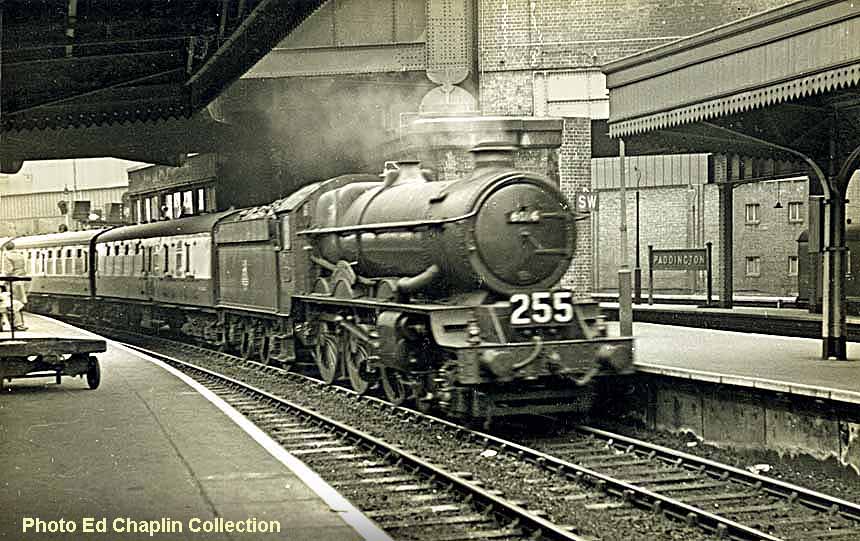
The list of numbers reproduced on this page to date are what I believe to be the Reporting Numbers of the regular express passenger trains on the Western Region from 1948 to 1965. Many of these numbers changed from one year to the next eg, from Monday 18 June 1951, the WR rationalised the number system that originated by the GWR in 1934, to give a better grouping of numbers. Each year later there were more changes but the  1951 approach in general lasted until a total revision was made for the 1958 Winter timetable.
1951 approach in general lasted until a total revision was made for the 1958 Winter timetable.
Reporting numbers were carried on three 20" black plates on a 3 foot-wide frame fitted to the locomotive's smokebox door (left). Alternatives to plates were stencilled numbers pasted on a small board (lower right) or the number was chalked or whitewashed on the smokebox door by hand (lower left).
Upon completion of its journey, the plate or board or chalked number should be  removed from the loco as part of being serviced before for its next duty, however this was not always the case and which gave rise to several caption errors in photographs.
removed from the loco as part of being serviced before for its next duty, however this was not always the case and which gave rise to several caption errors in photographs.
Many more express trains than these ran across the Western Region, but were not numbered. The trains with numbers were perceived as important to enable signalmen and staff to recognise an approaching train, at a distance of at  least a quarter of a mile enabling him to direct it at junctions or to the correct platform at a large station such as Paddington.
least a quarter of a mile enabling him to direct it at junctions or to the correct platform at a large station such as Paddington.
Many holiday trains that ran on the Western Region began or ended on other BR Regions, and were given WR Reporting Numbers during their journey on the WR, in place of any number relating to the other Region. Numbered trains did not all carry their number for their full journey, eg trains to Minehead had a loco change at Taunton, and carried the number no further. Trains in Cornwall usually did not carry the number beyond Plymouth, and likewise north or west of Shrewsbury.
Many of the WR steam years are being prepared (indicated (Under construction)) for posting on this page in the months to come. In all lists Paddington is abbreviated to Pdn.
The Reporting Numbers noted include the following abbreviations…
D - Daily (i.e. Mon - Sat and Sun), every day of the year.
FN - Friday night, i.e. overnight and reaches destination on Saturday.
FO - Friday only.
FSO - Friday and Saturday only.
FSX - Monday - Thursday only.
MFO - Monday and Friday only.
MX - Except Monday (i.e Tue - Sun).
Q - Ran as required.
SN - Saturday night i.e. overnight and reached destination on Sunday.
SO - Saturday only.
SuO - Sunday only (including overnight and reached destination on Monday.
SX - Saturday excepted (i.e. Mon - Fri).
W - Every Weekday (i.e. Mon - Sat)
It should be noted that many additional Friday night and Saturday trains were introduced for each Summer timetable, and then ceased to run on or before the start of each Winter timetable. These additional trains were termed 'dated trains' in that they only ran on Friday night or Saturdays between specified dates within the Summer timetable and not throughout.
Finally, I have shown departure times on the 24-hour clock basis, which was not introduced by BR until the 60s. I did this to minimize errors and for consistency.
Meanwhile those site visitors with knowledge of this subject are encouraged to help with this work; if you can, please contact the email address at the bottom of the page...
By way of a change, the page includes a number of features relating to historical events that helped shape both the Great Western Railway and British Railways Western Region, beginning with a brief outline of the 'Torquay Limited Pullman'. This abridged essay is based on details gleaned from John Copsey's splendid article which appeared in the 'Great Western Journal' Issue Number 64 Autumn 2007…
PULLMANS TO THE WEST
Monday, 8 July 1929 was a day of note for passenger traffic on the Great Western. In the first instance, the initial run to the 70-minute schedule of 'the world's fastest train' - the 'Cheltenham Flyer' - took place, with a 69 minute journey over the 77 miles from Swindon to Paddington behind 5000 Launceston Castle. The day also witnessed the use of the new 60ft stock marking the 25th anniversary of the 10.30am 'Cornish Riviera' with 6000 King George V at the head. In addition, a third, and rather unusual, event occurred at Paddington with the introduction of Pullman stock on the new 11.0am Paddington 'Torquay Pullman Limited' to run on a regular basis.
The inaugural service left Paddington platform 4 at 11.0am, calling at Newton Abbot and Torquay en route to Paignton due 2.50pm. The return from Paignton was made at 4.30pm, calling at Torquay and Newton, due  into platform 8 at Paddington at 8.30pm. The train was scheduled to operate initially on Mondays and Fridays only, with 8 coaches.
into platform 8 at Paddington at 8.30pm. The train was scheduled to operate initially on Mondays and Fridays only, with 8 coaches.
The winter service 1929/30 was arranged for 3 days a week, Mondays, Fridays and Saturdays. For this, the train was reduced from 8 to 6 coaches. Despite the prestige of the Pullman trains, with supplementary charges, customers were not high. Indeed the up and down Torbay Express ran as usual, 12 noon ex Paddington and 11.25am ex Kingswear to slightly faster timings, with no supplementary charges.
For the 1930 Summer season, the Torquay Pullman Limited ran daily; six Pullman coaches to Paignton, but on Saturdays also carried a 4 car non-Pullman Kingsbridge portion, detached at Newton. The return service just comprised the six Pullmans.
Poor patronage caused the GWR Traffic Committee to reassess the situation, and they decided to cease the train at the end of the 1930 Summer season. When this train ended, the Pullman cars were sent to the Southern Railway, Western Section in January 1931, for their use on such as with Ocean Liner boat trains.
But this was not the end of Pullmans being used on the GWR or BR (WR): during the Forties the occasional car could be seen on special services, and in 1955 saw the establishment of the South Wales Pullman. Later there were the Blue Pullmans, descriptions of which are to be found elsewhere. 
(Above) Departing Paignton at 4.30pm, 'Castle' class No 4087 Cardigan Castle, of Newton Abbot shed, is captured by the camera passing Starcross Harbour with the up 'Torquay Pullman Limited' to Paddington in 1930. The Pullman cars carry roof boards reading Torquay Pullman Limited.
(Below) In the summer of 1930, passengers on the down 'Torquay Pullman Limited' are about to be treated to their first glimpse of the sea, as Old Oak Common's 'Castle' class No 4075 Cardiff Castle skirts the River Exe estuary at Powderham Park, just seven miles from Exeter near Starcross. The train has 6 Pullman cars plus a 5-coach portion of ordinary stock, doubtless the Kingswear portion.
Summer 1948 - 31 May 1948 - 26 September 1948.
(Above-Below) Still carrying its GWR-style number on the buffer beam, 'Castle' class No 5036 Lyonshall Castle of Old Oak Common, makes a spirited climb of Hatton Bank with train 975, the 9.10am Paddington-Birkenhead express in 1948. With one mile at 1 in 100, many trains required the assistance of a banker or a pilot engine to surmount the 5-mile climb to Hatton station, 112 miles from Paddington. (Below) Introduced to traffic on 12 May 1948, No 7008 Swansea Castle was the first member of 'Castle' class to be completed under British Rail auspices; the loco is seen here heading an express away from the Birmingham area after Solihull near Bentley Heath on 11 September 1948. The GWR tradition of painting the loco number on the buffer beam was continued, as seen here. 7008 spent almost all its life operating from Oxford shed until it was withdrawn in September 1964.

(Below) A magnificent photograph of Gloucester shed's 'Castle' class No 7004 Eastnor Castle bursting out of Sapperton tunnel with the 4.55pm Paddington-Cheltenham Spa on 18 May 1948. During its 114 mile journey from London its scheduled first stop is Kemble at 6.32pm, some ninety one miles out of the capital, then it faces a 4-mile climb to the summit at Sapperton tunnel, followed by a downhill run all the way to its next stop at Stroud at 6.53 pm, aiming to reach Gloucester (Central) at 7.10pm. Here a 2-6-2T will back on to the rear and depart at 7.16pm with five carriages for the short 6½ mile run to the WR stations at Cheltenham Spa (Malvern Road) then (St. James's) where it will terminate at 7.35pm. 
Winter 1948 - 27 September1948 - 22 May 1949.
(Under construction)
Summer 1949 - 23 May 1949 - 25 September 1949.
This PDF link (right) contains what I believe to be the Reporting Numbers of regular express trains as per the Summer Timetable from Monday 23 May to Sunday 25 September 1949. The list shows when the number was to be carried, but this does not mean the train was limited only to run on the day when a  number was carried. An example is a Bank Holiday Mondays when an otherwise Saturday Only train would also run.
number was carried. An example is a Bank Holiday Mondays when an otherwise Saturday Only train would also run.
Unless otherwise said, Manchester means the main station at London Road. Several long distance weekday trains from the West Country to the North, shown as Penzance, Kingswear, Paignton, and Liverpool, Manchester often carried a portion to the other destination; similarly trains destined for Crewe had portions for both Liverpool and Manchester. I have only shown the start & end places for what is regarded as 'the main train'.
Many of the FO and SO trains were 'dated trains', in that they only ran between limited periods within the Summer Timetable.
D - Daily (i.e. Mon - Sat and Sun), every day of the week.
FO - Friday only (including overnight).
MX - Mondays excepted (i.e. Tue - Sat and Sun.
Q - Ran as required.
SO - Saturday only. SuO - Sunday only.
SX - Saturday excepted (i.e. Mon - Fri)
W - Every Weekday (i.e. Mon - Sat)
On a final note, some of the PDFs accompanying the webpage might, despite considerable effort, contain errors and missing details. My purpose has always been to compile the lists of WR Train Reporting Numbers for myself, however I am willing to share my best shot so far with others, and welcome additions and corrections to get the thing right.
POLITE NOTICE. The PDFs on this page are protected by copyright and reproduction is prohibited without the prior consent of the © owner. If you are unclear how copyright legislation works, there is a term called 'Fair Dealing' which describes the extent one can use copyrighted material without seeking authorisation.
1) A copy can be made for the purposes of research or private study.
2) A copy can be made for non-commercial purposes, providing the source of the material is acknowledged.
3) The person downloading material cannot make further copies available to others...in other words, they must not profit from it!
Ed Chaplin does not profit from this PDF. His sole aim is to share his research with others; it is simply a question of respecting his rights as the originator of the work and only using the material when it is correct to do so. If you wish to use the contents of his PDFs for any other reason please contact the email addresses to be found at the bottom of the page
Winter 1949 - 26 September 1949 - 4 June 1950.
(Under construction)
Summer 1950 - 5 June 1950 - 24 September 1950
(Under construction)
The 'Red Dragon' title was inaugurated on 5 June 1950, and applied to the 7.30am ex-Carmarthen, and 3.55pm return from Paddington. The up train was due at Paddington at 1pm, the return trip did not arrive at Carmarthen until 12 minutes before midnight.
(Above) From high standards in Wales to mistaken identity at Paddington! 'Castle' class No 4094 Dynavor Castle arrives with the up 'Red Dragon' at Cardiff, where No 5055 Earl of Eldon is waiting to take the train on to London. The up train started at Carmarthen at 7.30am for the 30 miles to Swansea, with 5 coaches, 6 on Mondays and Fridays, or when traffic demanded. It arrived at High Street station facing the wrong way, and 2 coaches were added at what was now the front. A new loco from Landore came on, and departed Swansea at 8.15am, making a number of stops, Neath, Port Talbot, Bridgend before arriving at Cardiff, some 45¾ miles later at 9.48. A separate portion departed High Street 30 minutes later with a  Landore engine at 8.45 and then ran nonstop to Cardiff, where the two portions were combined; the train now consisted of two restaurant cars, for it was not until departing Cardiff that refreshments were available on this service. After changing locos to one of Canton's very best, the train departed Cardiff at 10am calling at Newport 10.17-10.21 then did the 133½ mile non-stop run to Paddington, arriving there at 1pm. The Transport Treasury's huge archive of high-quality original negatives and slides are entrusted to the company by like-minded railway enthusiasts…click HERE to visit the website.
Landore engine at 8.45 and then ran nonstop to Cardiff, where the two portions were combined; the train now consisted of two restaurant cars, for it was not until departing Cardiff that refreshments were available on this service. After changing locos to one of Canton's very best, the train departed Cardiff at 10am calling at Newport 10.17-10.21 then did the 133½ mile non-stop run to Paddington, arriving there at 1pm. The Transport Treasury's huge archive of high-quality original negatives and slides are entrusted to the company by like-minded railway enthusiasts…click HERE to visit the website.
(Inset) The WR booklet Winter (17 September 1956 to 16 June 1957)shows the 'up' ex-Carmarthen train stopping at Ferryside, Kidwelly, Pembrey & Burry Port, Llanelly, Loughor, Gowerton North, Cockett then Swansea Hight Street, Cardiiff, Newport, then non-stop to Paddington. On the return journey, it departed Paddington at 5.55pm calling at Swindon 7.26-7.29pm and Badminton 7.56-7.59pm, arriving at Newport 8.47pm.
(Below) This is an interesting shot of Cardiff Canton's 'Britannia' No 70029 Shooting Star awaiting departure from Paddington with the down 'Capitals United Express' circa 1957. Rather confusingly the locomotive still carries the up 'Red Dragon' number, which it had worked from Cardiff earlier that day. After being turned at Ranelagh Bridge, the usual next duty for this loco was the down 'Capitals United Express' scheduled for a 3.55pm departure from Paddington; clearly someone had forgotten to change the reporting number and so we have both train identities appearing on the one loco! This was very unusual for those at Ranelagh Bridge depot and the loco crew, since it was a daily procedure. 
Winter 1950 - 25 September 1950 - 17 June 1951 (Under construction)
As from the start date of the Winter 1950 timetable, the title 'Inter-City' was awarded to a new service, the 9.00am Ex-Paddington, calling only at High Wycombe, to reach Birmingham at 11.00am, continuing for 25 minutes to reach Wolverhampton. The return trip left Wolverhampton at 4.25pm and Birmingham at 4.50pm but these were later altered to 4.35 and 5.00 to conform to the hourly Snow Hill departures, resulting in a Paddington arrival time of 7.10pm.
Towards the end of 1950, British Railways announced that a number of trains would be given names for the Festival of Britain in 1951. Two such trains were named the 'William Shakespeare' and 'Merchant Venturer'. The former was inaugurated on Friday 18 May 1951 from Paddington and was the 10.10am express to Wolverhampton, now with a 3-coach portion to Stratford-on-Avon, detached at Leamington Spa about 11.45am. For its return journey, the 3 coach up train was attached to the 7.50pm ex-Birmingham at about 8.15pm at Leamington, reaching Paddington at 10.10pm. The Merchant Venturer was announced as to be between Paddington and Bristol, with no mention made of it continuing to Weston-super-Mare, although that happened and it seems to have been inaugurated without ceremony on or before Thursday 3 May 1951. This was the existing 11.15am departure from Paddington with train number 172; although within two months, this changed to 142. It has been widely stated that this title was inaugurated on Monday 18 June, but that is not correct.

(Below) On Friday 11 May 1951, Laira's 'Castle' class No 111 Viscount Churchill pauses at Newton Abbot with a military train number 11F15. This locomotive was converted from GJ Churchward's solitary 4-6-2 Pacific 'The Great Bear' in 1924 (see next caption below) and was shedded at Old Oak Common from new until one year before this photograph by DM Rouse was taken. The loco has a unique pedigree and a very unusual number, when one considers that all other conversions to Castles had numbers in the 4000 and 5000 series. The loco was withdrawn in July 1953. 

(Above) Strictly speaking these photos of 'The Great Bear' are out of sequence with the content of this page, but they do relate to the photograph of the 'Castle' class mentioned above. Built at Swindon in February 1908 as a larger version of the 'Star' class, the Great Bear was the only one of its type to be built by the Great Western Railway and the very first Pacific locomotive to run in Great Britain - Gresley's Class A1 4-6-2 No 1470 Great Northern did not enter traffic on the GNR until 1922, just a year before the company was incorporated into the newly-formed LNER in the 1923 Grouping. The unique Pacific No 111 was considered the company's flagship, and since it was the country's largest locomotive at that time it proved a great PR success, but in service conditions the locomotive did not show any significant improvements on existing 4-6-0 classes, plus its heavy 20t 9cwt axle load led to it being limited to the Paddington-Bristol route, usually on the 11.00 Down express and back on a fitted freight - and then only after the skew bridge over the Uxbridge Road at Hanwell, 7½ miles out of Paddington had been rebuilt. However, there was some justification for its use on the London-Bristol service as it was much used by businessmen, and many fast trains operated on the route. But after 15 years in service No 111 was withdrawn from traffic on 7 January 1924 and taken into Swindon Works. It reappeared in September that year virtually as a new engine incorporating only the front end of 'The Great Bear' and not even its tender was used; the new 'Castle' class was named 'Viscount Churchill' after the then Chairman of the Great Western Railway. My thanks to Ben Brooksbank for additional information. 
Summer 1951 - 18 June 1951 - 9 September 1951
The introduction and duration had been announced to be from Monday 18 June - Sunday 23 September, and all timetables printed and public announcements were to that effect. However, at a late change, due to the continuation of heavy freight traffic in industrial areas and a shortage of crews, the Railway Executive decided to narrow the Summer 1951 services to Monday 2 July - Sunday 9 September. Despite that decision, demand required a gradual increase in the number of Saturday holiday trains from the middle of May 1951 to the extent that in late June, most of the Summer holiday extras hitherto planned, did run in one form or another. The significantly revised WR Reporting Numbers, set to take effect from Monday 18 June 1951, did not apply until Monday 2 July. From Monday 18 June - Sunday 1 July 1951, the Summer 1950 series of numbers continued to be used. The Bristolian title was reintroduced as from 2 July to the 9.05am ex Paddington and return from Bristol; but it was not until 14 June 1954 that the high speed Bristolian came about, departing Paddington at 8.45am and running non-stop to reach Bristol for 10.30am in 1¾ hours. The return trip departed Bristol at 4.30pm, also taking 1¾ hours to be at Paddington for 6.15pm.
(Below) 'Castle' class No 5079 Lysander of Newton Abbot shed (83A) heads the down 'Torbay Express' on Wednesday 13 June 1951, only a short time before the delayed 1951 Summer timetable came into operation on 2 July and all reporting numbers were revised; the down 'Torbay Express' subsequently became 146. On a Wednesday, the first stop for the down train was Exeter (2.52pm-2.57pm) followed by Torquay (3.35pm-3.39pm) then Kingswear by 4.10pm. No 5079 will haul the train throughout the 208½ miles. The loco was first built in May 1939 as Lydford Castle, and acquired its new name (one of twelve Castles renamed after WWII aircraft) in November 1940. It became one of the five Castles converted to oil-burners between January 1947 and September 1948. During that time it was in constant use between Newton Abbot and Penzance, and OS Nock had runs behind it that he described as 'excellent'. Withdrawal came in May 1960. 


(Above) 'Castle' class No 7007 Great Western of Worcester shed (85A) is seen entering Exeter St. David's with train 518, the 11.25am up 'Torbay Express' from Kingswear, timed at 12 noon from Torquay, 12.40pm at Exeter and then a non-stop run for a 3.35pm arrival at Paddington. During the early 50s there was a curious Worcester shed diagram in which the shed's loco worked an up service from Worcester to Paddington, then the next day's down Torbay Express followed by the up Torbay Express the day after that, this being one of them.
(Below) 'Star' class No 4042 Prince Albert has just replaced 'Castle' class No 5044 Earl of Dunraven on the down 'Merchant Venturer' at Bristol Temple Meads on 26 May 1951. No 5044 can just be seen on the right with train number 172 fitted, before it goes forward to Bath Road shed to be serviced. The headboard on 4042 looks in a very new condition, as it should be for this train was named just three weeks before. The titled train was due to arrive at Bristol at 1.22pm, and the 20 miles from here to Weston-super-Mare will be done within half an hour on level track, an easy run. Built in May 1913, this Star class loco was fitted with 'elbow' type steam pipes in May 1948, but by the time this photograph was taken in 1951 No 4042 has only a few months to go before withdrawal from Bristol Bath Road in November. 

(Above) The first of the 'County' class, 1000 County of Middlesex, emerged from Swindon Works in August 1945, fitted with a double chimney from new. Its first home shed was Old Oak Common followed by Laira in December 1951 and then Chester in October 1952. In March 1954 its home shed became 82A Bristol Bath Road, and so it is captured here at Temple Meads with the up 'Merchant Venturer', departing at 5.27pm for Paddington, due there at 8.05pm. En route it will stop at Bath, Chippenham, Swindon and Reading. For the Summer 1954 timetable only, the 'Merchant Venturer' was accelerated by omitting the stop at Swindon with arrival at Paddington by 7.33pm. To do this, the 94-mile stretch from Chippenham was booked to take 90 minutes. The train number 475 remained the same from 1951 for seven years, so I cannot date this shot more closely than the mid-50s, however it seems appropriate to feature it here beneath the previous photo of the down train. Upon closure of Bristol Bath Road to steam in September 1960, No 1000 moved with the other 82A locos to 82B St. Philip's Marsh. Its original double chimney was replaced by the newer squat design of double chimney in March 1958. The loco was withdrawn on 4 July 1964, and sold for scrap to Cashmores at Newport on 23 September 1964. Inserted into the sky is one of the locomotive nameplates measuring 87" long, which went under the hammer for £12,500 at a Great Central Railwayana Auction on 13 October 2012.
Winter 1951 - 10 September 1951 - 29 June 1952 (Under construction).
(Above) On 30 May 1952, Cardiff Canton's 'Castle' class No 5049 Earl of Plymouth arrives at Hereford on train 796, which I believe is a relief to 795, the 11.15 Swansea - Manchester London Road, ex-Cardiff 12.50 with a change of loco and number added. Having checked the date, the 30th was the Friday of the Whit weekend so it makes sense that this relief was running, probably from Cardiff only. Often the Canton loco that hauled 795 was turned at Shrewsbury and returned south still displaying 795. In contrast Cardiff Canton and Plymouth Laira were punctilious about having the right number on trains departing east or north from each.The newly introduced train number series continued with very few changes, one being the down Merchant Venturer from 142 to 143; before it reverted back to 142 at the next timetable change.
Summer 1952 - 30 June 1952 - 14 September 1952.
From Summer 1951, the Western Region rationalised the number system originated by the GWR in 1934, to give a better grouping of numbers. Each year later there were more changes but the 1951 approach in general lasted until a total revision was made for the 1958 Winter timetable. The Summer 1952 numbers were almost all the same as those applied in Summer 1951.
Many trains shown as to Plymouth or Penzance also included a portion (under half the coaches in a train) for the line terminating at Kingswear, which was detached from the main train at Exeter or Newton Abbot, and then taken forward, perhaps strengthened by additional coaches. An equivalent procedure applied in the reverse direction. I have not shown these subtleties, so as not to lessen the main destination of the train.
The Summer timetable 1952 ended Saturday 14 September and all, with very few exceptions, Friday Night and Saturday Only trains ceased. Indeed most trains listed here as FO or SO ran only on specified periods within the 30 June - 14 September timeframe, at school holiday, town holidays and Wakes Weeks times; and these were termed 'dated trains'.
Finally, to minimize errors and for consistency, I have shown departure times on the 24-hour clock basis, although it was not introduced by BR until the mid-60's.
The lists show when the number was to be carried, but this does not mean the train was limited only to run on the day when a number was to be carried. An example is the 12.05 ex-Paddington, which also ran on a Friday but without passengers: instead it consisted of a set of empty restaurant cars, one car each for the next day's up trains designated to provide dining facilities (see photo in Summer 1959 section below).
Another example is Bank Holiday Mondays when an otherwise Saturday Only train would also run.
D - Daily (i.e. Mon - Sat and Sun), every day of the year.
FN - Friday night, i.e. overnight and reaches destination on Saturday.
FO - Friday only.
FSO - Friday and Saturday only.
FSX - Monday - Thursday only.
MFO - Monday and Friday only.
MX - Except Monday (i.e Tue - Sun).
Q - Ran as required.
SN - Saturday night i.e. overnight and reached destination on Sunday.
SO - Saturday only.
SuO - Sunday only (including overnight and reached destination on Monday.
SX - Saturday excepted (i.e. Mon - Fri).
W - Every Weekday (i.e. Mon - Sat).
(Below) On Saturday 26 July 1952, 'Grange' class No 6828 Trellech Grange of Stourbridge Junction shed (84F) restarts the 2.05pm SO Weston-super-Mare-Birmingham from Stratford-on-Avon, before tackling the 1 in 75 climb of Wilmcote on the final 25 miles to Birmingham. Note GWR livery tender which was fitted 6 weeks earlier. 

(Above) Heading towards Wellington Bank on the Somerset-Devon border, Laira shed's 'Castle' class No 5023 Brecon Castle is in charge of the down 'Torbay Express' on a sunny Saturday 13 September 1952. Departing Paddington at 12 noon, the practise on a Saturday was to run non-stop from Paddington to Torquay, a distance of 199¾ miles. It was unusual for a Laira Castle to be used, as the up and down train duties were shared on alternate days by Old Oak Common and Newton Abbot sheds. But on Saturdays, out of the ordinary things did happen. Photo is by RHG Simpson.
(Below) I doubt whether the frame with the numbers could be secured any higher than on 'Saint' class No 2933 Bibury Court as it takes the 07.45am ex-Worcester through West Ealing station in 1952, due to arrive at Paddington a few minutes after 10.00am. One can just discern the 84D Leamington shed plate; this was 2933's home shed prior to nationalisation on 1 January 1948 up to withdrawal in January 1953. Built in November 1911, No 2933 was one of a class of 25 locos rated 4P in the power classification. Between 1923 and 1925 the blast pipe position and the chimney were moved forward, and all 25 of these Court-named locos within the Saint class, survived into British Railways days. Photo is by CRL Coles.
(Below) In August 1952, 'Castle' class No 5065 Newport Castle, an 81A Old Oak engine, brings the empty stock from Malago Vale sidings for a 4.15pm departure from Bristol Temple Meads station of the up 'Bristolian' to London. This dates from before the Bristolian became 'high speed' as from 14 June 1954, and ran non-stop to Paddington in 1¾ hours. The Reporting Number digits have, most unusually, been fitted in the wrong order, they should be 470. 
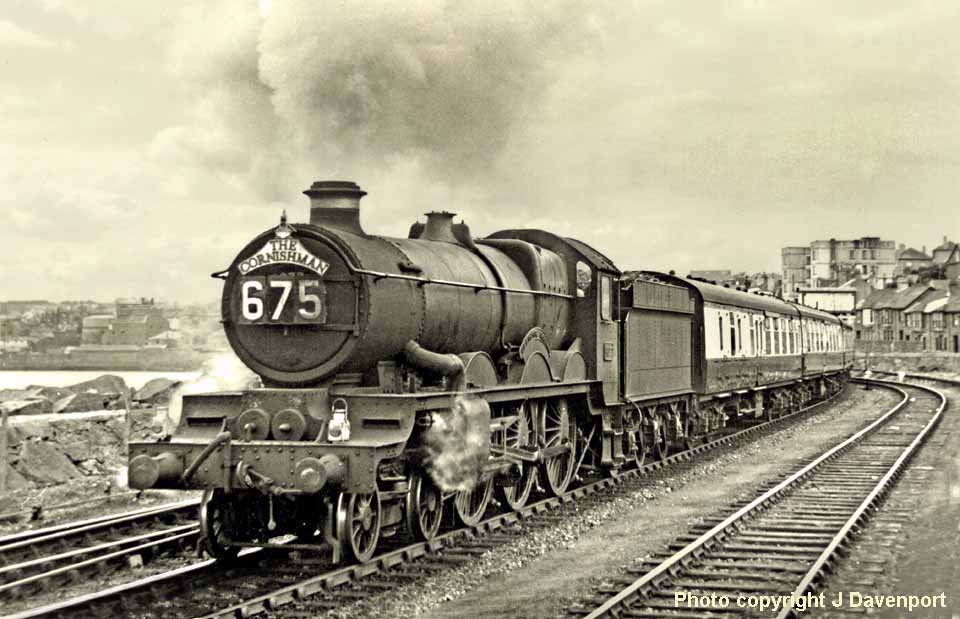
(Above) Reporting numbers were not carried by the majority of through expresses to Cornwall, however an occasional exception was the 'Cornishman'. The number for the northbound train was 675, southbound 825 from the Summer 1952 up to and including the Summer 1958 timetable. Here 'Castle' class No 4077 Chepstow Castle departs Penzance on 22 July 1957.
The title 'Cornishman' was introduced in the Summer 1952 timetable, the train ran on Mondays to Fridays, the northbound train left Penzance at 10.10am. It was due Plymouth North Road at 12.50pm. The arriving loco came off and a Laira loco came on, due to leave at 1.00pm. The train then ran non-stop, not even stopping at Newton Abbot, direct and due at Exeter St. David's at 2.15pm. Separately, the South Devon portion of the train left Kingswear at 12.15pm and stopped at most stations till it reached Exeter. It called at Newton Abbot (1.20 - 1.24pm) and usually carried the headboard but it was not an 'A' class train, it was a semi-fast with many stops, and four carriages or so. It was hauled by a Newton Abbot loco that had gone down to Kingswear and turned there earlier. At Exeter, it was this loco that combined the Devon portion to the Cornwall portion, and took the combined train forward to Bristol, due there about 4 pm. Then it would come off and a Stafford Road loco would take the train on to Wolverhampton, due there about 7.25pm.
(Below) Ben Brooksbank shelters from a downpour of rain to photograph 'Grange' class No 6824 Ashley Grange on the southbound train at Truro. The locomotive still carries the northbound train reporting number. This is another case, like the Cambrian Coast Express, when the same loco took both up and down trains the same day, with the number for the first train being left fitted in each case.
The Summer timetable ended Saturday 14 September and all, with very few exceptions, Friday Night and Saturday Only trains ceased. Indeed many such trains ran only on specified periods within the 30 June - 14 September timeframe, at school holiday and Wakes Weeks times. The major revision of train numbers that became effective for Summer 1951 still applied, with minor changes such as the reversion of the down Merchant Venturer from 143 to 142.
WR trains numbered up to 985 existed and full lists of them for 1952 and many of the WR steam years are being prepared for posting on this page.
The Reporting Numbers noted in the 1952 Summer Timetable (below) include the following abbreviations…
D - Daily (ie Mon - Sat and Sun), every day of the week.
FO - Friday only (including late Friday into Saturday morning).
SO - Saturday only.
SX - Saturday excepted (ie Mon - Fri).
W - Every Weekday (ie Mon - Sat).

(Below) On Saturday 13 September 1952, RHG Simpson chose to photograph the 4 track section between Cogload Junction and Creech St. Michael, shortly before Taunton, where he fortuitously captured this shot of 'Hall' class No 4975 Umberslade Hall, of Canton shed, hauling train 705, the 9.05am SO Swansea - Kingswear, while 'King' class No 6008 King James II of Laira shed is on train 130, the down 'Cornish Riviera'. Cogload Junction is where the line from Bristol meets the new direct route from London via Newbury, some 138 miles from London.

Winter 1952 - 15 September 1952 - 7 June 1953
(Under construction)
Summer 1953 - 8 June 1953 - 20 September 1953 (Under construction)
(Below) Built at Crewe Works to Order No E483/228 Swindon 403 (the additional part of the order refers to Swindon's request to fit Western Region lamp irons and Automatic Train Control equipment) 'Britannia' Class 7MT No 70028 Royal Star entered traffic in October 1952, being among the first five Britannias to be allocated to Cardiff Canton MPD (86C) in South Wales where it enjoyed a long stint of almost nine years. Here 70028 makes a splendid sight hauling the 10.10am SO Paignton-Cardiff past Sprey Point between Teignmouth and Dawlish on Saturday 27 June 1953. 

(Above) BR Class 7MT No 70029 Shooting Star was the final BR Britannia to be allocated to the Western Region in November 1952. After completion of trials the engine joined classmates 70025-70028 at Cardiff Canton depot. During April 1953, both 70028-70029 and 70024 Vulcan were acquired by the Southern Region based at Exmouth Junction shed (72A) to substitute for the 'Merchant Navy' Pacifics, which had been withdrawn for examination following an incident involving No 35020 Bibby Line at Crewkerne on 24 April. By the end of June the MNs were back in traffic and the loaned 'Britannias' were returned to the WR. On Saturday 27 June 1953 (the very same day as the Teignmouth shot) BR Standard 7MT 'Britannia' class No 70029 climbs to Whiteball summit with the 09.18am Exmouth to Manchester on its way back to its home shed at Canton; this unique and fascinating inter-Regional train ran for many years well into the 1960s. Starting on the Southern Region, a SR Mogul or tank engine hauled the train to Exeter Central station, where a WR loco from Exeter shed (83C) reversed light engine up the hill to take the train down to Exeter St David's station. Departing Exeter at 10.08am the engine then continued over the WR main line to Shrewsbury via the Severn Tunnel where a London Midland Region locomotive replaced it for the remaining leg to Manchester. Additional information by Derek Frost; click HERE to visit the excellent Great Western Trust's website. Didcot is a must visit place for all WR fans; indeed why not get involved? The site contains full details.
(Below) No 4703, one of the very big Churchward 2-8-0s is approaching Shiphay Bridge, Torquay with train 543, the 8.40am SO Paignton-Nottingham on Saturday 27 June 1953. It was rare to use these locos, and an article by R Woodley in 'Steam Days' July 2013, gives plenty of information on known passenger express workings of this class. I think the loco's home shed is 82B St. Philip's Marsh. Photograph is by PW Gray.

(Above) The WR's first gas-turbine locomotive, the Brown Boveri-built A1A-A1A No 18000, was followed by a new British design, built by Metropolitan Vickers at their works at Trafford Park, Manchester. Numbered 18100, and mounted on Co-Co bogies, each axle of its two 6-wheeled bogies were independently motored. Here No 18100 arrives at Bristol with the down 'Merchant Venturer' on Saturday 22 August 1953. Departing Paddington at 11.15am, the 'Merchant Venturer' travelled non-stop to Bath - due at 1.01pm nearly 107 miles, followed by Bristol at 1.22 pm, another 11½ miles. 18100 will come off at Bristol and be replaced by a Bath Road engine for the final 19 mile stretch to Weston-super-Mare, due 2.04pm. The gas turbine locomotive was used more on this train than any other on the Western Region, but after repeated problems its short working life ended in November 1953, when it was taken out of service, languished at Swindon, and on 15 December returned to the Metropolitan Vickers plant. Over the next years, before scrapping in January 1973, the gas turbine kit was removed and electric power fitted instead, and the converted locomotive was renumbered as E1000, later E2001.
(Below) 'Hall' class No 4971 Stanway Hall of 83B Taunton shed leads Old Oak Common's 'King' class 6000 King George V on train 153, the 3.30pm Paddington - Penzance on Saturday 25 July 1953; the pair were photographed hurrying through Taplow station, 22½ miles from Paddington. In all probability, No 4971 had hauled the 9.05am Minehead-Paddington from Taunton earlier in the day therefore on arrival back at Taunton it will come off this train and the King will continue alone. 
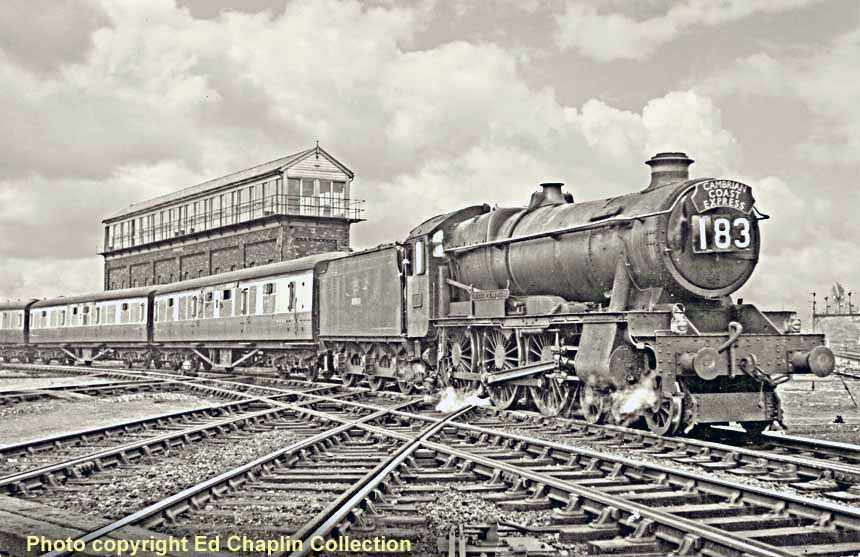
(Above) A somewhat grubby-looking 'County' class No 1008 County of Cardigan heads the down 'Cambrian Coast Express' past the massive signal box into Shrewsbury station in the summer of 1953. No 1008 was a Chester loco (84K), and my guess is it had hauled this train all the way from London, a distance of a little under 153 miles, departing Paddington at 10.10am and arriving at Shrewsbury at 1.20pm.
(Below) This superb picture shows 'Castle' class No 4076 Carmarthen Castle taking a lengthy semi-fast train out of Chester; the loco is coupled with a Hawksworth tender, so the date is probably circa 1953. This loco was based at 84K Chester shed from early 1949 to November 1957, hence it was rarely seen in the London area. In early 1956, when the bogies of the 'King' class required urgent remedial attention, No 4076 was one of the Castle class locos to be drafted in from outlying sheds to help cover for the absent Kings. It was seen bringing the 7.45am ex-Bristol, train 450 to Paddington on Sunday 5 February 1956. The 'Kings Crisis' as it was then called, began when two serious faults were found in quick succession following recent welded repairs to the King bogies. All 30 Kings were taken out of service from 23 January 1956, and these were spread around the Region at Old Oak, Bath Road, Swindon and Stafford Road. Three Kings were found to be unaffected, but to make matters worse, one week later, after urgent bogie repairs had begun, faults in the mainframes were then found. Two 'Duchess' Pacifics Nos 46254 and 46257 had already been borrowed from the LM Region, and the Castles were switched to take on other King duties. The LM Region loaned two more Class 8 Pacifics, Nos 46207 and 46210, plus eight BR Standard Class 5MT locos came from the LM and Southern Regions to help the Halls that had taken over some duties usually performed by Castles. From 18 February, one by one of the Kings were approved for a return to service and the drama, and overtime, began to subside.
1953 is very much work in progress, as I do not have a precise record of the numbers that applied during the 1953 Summer Timetable, but I do believe the vast majority of numbers remained the same as those applied during the Summer of 1952. I fear there may be some minor errors-omissions in the 500 - 599 range, however I am aware of several changes made for 1953 compared with 1952, and these are included in the list.
The Summer timetable 1953 ended Saturday 20 September and all, with very few exceptions, Friday Night and Saturday Only trains ceased. Indeed most trains listed as FO or SO ran only on specified periods within the 8 June-20 September timeframe, at school holiday, town holidays and Wakes Weeks; these were termed 'dated trains'.
Certain trains from South Devon to the Midlands had paths left for them from South Devon to Bristol, and then beyond to destination in the London Midland Region, depending on which town had their holiday fortnight, such as Castleton, Derby, Huncoat, Macclesfield etc. One important fact about 1953 is that the Coronation of Queen Elizabeth II took place on 2 June, and in the period shortly before and after that date, additional fitments signifying Coronation Crowns (see photos below) were added above the title plate of certain titled trains. I include this note here as it relates to June 1953, although the date of the Coronation was a few days before the Summer 1953 timetable began.
One important fact about 1953 is that the Coronation of Queen Elizabeth II took place on 2 June, and in the period shortly before and after that date, additional fitments signifying Coronation Crowns (see photos below) were added above the title plate of certain titled trains. I include this note here as it relates to June 1953, although the date of the Coronation was a few days before the Summer 1953 timetable began.
The lists show when the number was to be carried, but this does not mean the train was limited only to run on the day when a number was to be carried. The 9.55am down train that formerly operated to Neyland was now 'upgraded' to a weekday train, the Pembroke Coast Express, leaving Paddington at that time, reaching Swansea after 3 hours at 1.40pm, and the through portion finally reaching Pembroke Dock at 4.25pm.
(Below) To commemorate the Coronation of Her Majesty Queen Elizabeth II at Westminster Abbey on Tuesday 2 June 1953, the Western Region produced a number of crown castings to be fitted to titled train headboards; the crown can be seen in this splendid photograph of the up 'Red Dragon' at speed near Slough in late May 1953. In charge is Cardiff Canton's 'Britannia' Class 7MT No 70027 Rising Star (as ever in very clean condition) however at this time the shed's allocation of five 'Britannias' was down to just three when 70028/29 were loaned to the Southern Region's Exmouth Junction as substitutes for the withdrawn Merchant Navy Pacifics following an incident involving 35020 at Crewkerne on 24 April. It was not until 28 June that the loaned engines were returned to Canton. This photo is from the Locomotive & General Railway Photographs collection Ref No 23344. A history of how this fantastic archive of railway negatives began can be found HERE. The collection is now held by the National Railway Museum Research Centre, National Railway Museum, York YO2 4XJ...a visit is highly recommended. 

(Above) This late-May 1953 photograph shows recently-overhauled 'Castle' class No 5081 Lockheed Hudson of Old Oak Common ready to leave on the 9.05am 'Bristolian' to Bristol via Bath; on the right another Old Oak Common engine, 'King' class No 6013 King Henry VIII is about to depart with the 9.00am 'Inter-City' to Birmingham and Wolverhampton. Note both headboards are decked with Coronation Crowns. This JM Craig photo is now in the Ray Hinton archive.
(Below) Bearing a 'Cornish Riviera' headboard topped by the Coronation crown, Laira's 'King' class No 6017 King Edward IV bursts into daylight from the 513-yard Parson's tunnel between Dawlish and Teignmouth on Wednesday 25 May 1953. Several WR titled trains carried the crowned headboards before and on the day of Coronation itself, Tuesday 2 June; indeed some headboards included the letters 'ER' indicating 'Elizabeth Regina'; Regina is Latin for 'Queen', hence the meaning 'Elizabeth the Queen'. For the record, Parson's Tunnel signal box is here at milepost 207½, which overstates the mileage from Paddington by 20 since the building of the shorter line via Newbury and Westbury. But the mileposts from Cogload (before Taunton) onwards still show the longer mileage based on the original Great Way West via Bristol, and other changes after Exeter.
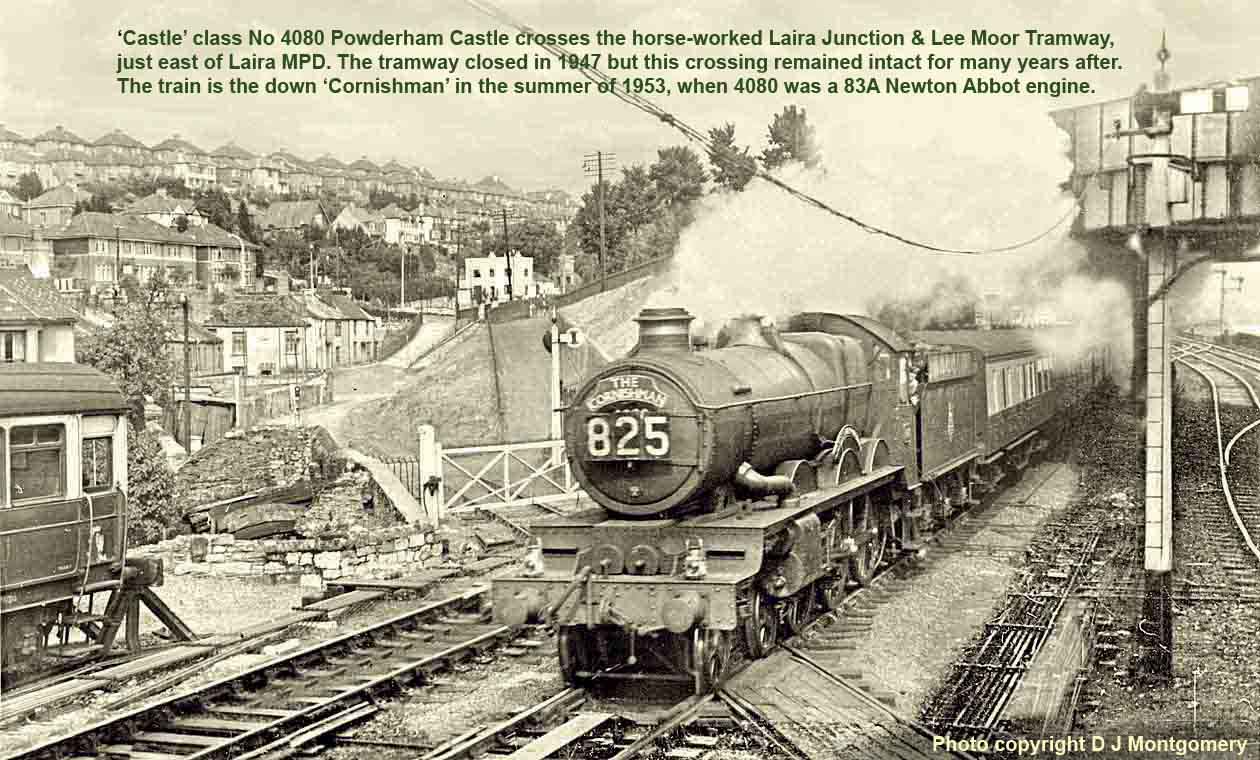

(Above) Built at Crewe in August 1951, BR Class 7MT No 70022 Tornado was the second of four 'Britannia' Pacifics allocated to Plymouth Laira depot (83D), however only eight months were spent there before its transfer to Newton Abbot Shed (83A) for a period of over four years; at the end of 1956 it joined the concentration of Western Region Britannias at Cardiff Canton (86C). On Saturday 29 August 1953, 70022 Tornado departs Paddington with the 12 noon 'Torbay Express' to Kingswear. Being a Saturday the train was scheduled to run a little under 200 miles non-stop to Torquay, however with the density of Summer holiday traffic this would be severely challenged. In the summer of 1957, the loco underwent extensive modifications during a General Overhaul at Swindon Works; this included the removal of the smoke deflector handrails which were replaced by six brass-lined cut-outs in each sheet; these added considerably to the overall appearance of the WR Britannias, as they were usually kept in very smart condition by staff at Cardiff Canton MPD. A full history of the Britannia class locomotives Nos 70000-54 can be found on Derek Dean's excellent Britannia pages starting HERE. 
(Above-Below) Perhaps both rear offside and nearside views of the Western Region's self weighing tenders will be of interest to the discerning modeller; 'Castle' class No 5086 Viscount Horne of Worcester shed was photographed at Oxford on 8 January 1953 coupled with self weighing tender No 4127, not shown in official records; the tender was finished in lined green. (Below) This is evidence that 'County' class No 1029 County of Worcester ran with a self weighing tender during its allocation to 84A Stafford Road in 1952-3 prior to its move to Neyland in December 1953. It is seen here reversing into Shrewsbury station. Introduced to traffic in April 1947, 1029 was the last of the Class 6MTs to be built. 

(Above) With Shrewsbury's Severn Bridge Junction signal box visible in the background, 'Castle' class No 5080 Defiant takes the line to Hereford displaying a wrong number 795, the 11.15am Swansea-Manchester from its previous run; the train is likely to be the 3.00pm Liverpool-Cardiff and the self weighing tender dates this photograph as July 1953. From 1952 each BR Region deployed coal-weighing tenders so that engineers could more accurately record a locomotive's coal consumption during tests. The tenders were equipped with a separate bunker suspended on pivots which were connected to steelyards; the bunker assembly was fixed when the loco was working and released when the contents of the coal space was to be weighed. The quantity of coal used on the test was measured by weighing the coal deposited in the tender prior to starting, then during the test and the residue was weighed again at the end of the run. The weight difference, taking into account the amount used for lighting up, gave the total consumption over the route.
(Below) Two Castles in view, one of metal, one masonry. 'Castle' class No 5005 Manorbier Castle heads the 11.55am Manchester (London Road)-Plymouth, while across the fields is the 13th century Stokesay Castle (No 5040 in the fleet). No 5005 was a Canton engine, but it was not uncommon to find such locos hauling expresses to or from elsewhere along this North and West route. Just discernible in the left foreground is MP21¼, the number of miles south of Shrewsbury where 5005 took over the train from a London Midland Region loco.
Winter 1953 - 21 September 1953 - 13 June 1954
(Under construction) 
(Above) Enduring the bitingly cold winter conditions, railway photographer-artist, George Heiron, captured 'Castle' class No 4091 Dudley Castle of Bath Road shed, storming through Badminton station at the head of the 11.45am Bristol - Paddington on Wednesday 27 January 1954.
(Below) 'Castle' class No 5031 Totnes Castle of Stafford Road shed is returning home with train 673, the second part of the Cornishman  (train 675) on Saturday 3 April 1954. 673 was an otherwise unused number, and is used as today's traffic is busy although Good Friday is not till 16 April, 2 weeks away, when this train is bound to be run. Note that the Cornishman headboard, reversed, is secured above the number frame. Photo is by TE Williams.
(train 675) on Saturday 3 April 1954. 673 was an otherwise unused number, and is used as today's traffic is busy although Good Friday is not till 16 April, 2 weeks away, when this train is bound to be run. Note that the Cornishman headboard, reversed, is secured above the number frame. Photo is by TE Williams.
(Inset) Appearing for sale at auction for the very first time, an interesting lot comprising the nameplate, brass cabside and smokebox numberplates of 'Castle' Class 4-6-0 locomotive 5031 Totnes Castle went under the hammer at a UK Railwayana Auction in May 2014. Built Swindon in June 1934, No 5031 was withdrawn from 2B Oxley shed and placed in store in October 1963; the loco was cut up at Cohens, Morriston, Swansea in May the following year. Click HERE to visit the fascinating UK Railwayana Auctions website. 
(Below) Amidst the rolling Monmouthshire countryside near Pandy, 'County' class No 1022 County of Northampton of 84K Chester tackles the 1 in 100 climb to Llanvihangel, some twenty miles south of Hereford, with a southbound express on Maundy Thursday, 15 April 1954. 

(Above) In the opposite direction, Canton's 'Castle' class No 5049 Earl of Plymouth will have had a harder time reaching Llanvihangel, 24 miles from Newport, as it faced stretches of 1 in 82, 85 and 95, and may well have been delayed by this slow moving freight hauled by WD 2-8-0 No 90179, now resting in the up loop. The photo was taken by GW Sharpe in April 1954..
Summer 1954 - 14 June 1954 - 19 September 1954
(Under construction)
(Above-Below) This photograph of 'Britannia' class No 70027 Rising Star and 'Castle' class No 7016 Chester Castle arriving at Paddington with the 'Red Dragon' on Friday 30 July 1954 is a good example of Canton sending up locos to London as a means of providing motive power for two down trains later that day. (Below) On a weekend date in August 1954, 'Castle' class No 5058 Earl of Clancarty heads train 636, the relief Riviera, 12.15pm ex-Plymouth North Road through Dawlish Warren station. This train seemed to run 'as required', except Saturdays, and indeed did start off from Penzance at 9.45am on occasions, however haulage from Plymouth was 'whatever could be found' ranging from a Class 5MT 'Hall' to a Class 8P 'King'. Today it is a Class 7P 'Castle' with a scratch crew of carriages, but at least it did provide seats when otherwise it would be much standing in the corridor.

Winter 1954 - 20 September 1954 - 12 June 1955
(Under construction)
(Above) Old Oak Common's 'Castle' class No 5034 Corfe Castle returns to London with train 718, which started off from Fishguard Harbour at 4.55am on Saturday 7 May 1955. No 5034 took over at Cardiff, aiming to reach Paddington for 11.45am As it was FA Cup Final Day at Wembley Stadium, perhaps some football enthusiasts were on the train, as there was plenty of time for them to get to the match, in which Newcastle beat Manchester City 3-1. Having said that there was a football special running that day from Cardiff to Paddington, train 070, hauled by Canton's 5046 Earl Cawdor. Photo is by EH Sawford.
(Below) Having recently arrived at Bristol Temple Meads with the 'Merchant Venturer', 'King' class No 6009 King Charles II, an Old Oak loco all its life, is about to be disposed of at Bath Road shed whilst 'Hall' class No 4967 Shirenewton Hall is backing on to take the 'Merchant Venturer' on to Weston Super Mare. The date is Saturday 16 April 1955, and the Saturday down service times were no different to other weekdays, leaving Paddington at 11.15am., first stop Bath at 1.01pm., Bristol at 1.22pm, except a further 8 minutes was allowed at Bristol for the change of loco, so today it was due at Weston at 2.04 pm. Photograph is by RE Toop. 

(Above) On Saturday 19 February 1955, 'Castle' class 5053 Earl Cairns of Newton Abbot shed is taking the Down Relief line through Sonning Cutting. There must be a reason why the down Torbay Express is on the Relief line on a Saturday, or perhaps the date is incorrect; it is quite possible the photo was taken on a Sunday when both the up and down relief lines were commonly used for expresses. The train length looks a bit on the short side, but that is not so, seven coaches was the norm.
(Below) The Cornishman was usually made up of two portions, one from Kingswear, and one from Penzance, combining at Exeter. However when demand was very heavy this was replaced by two separate full length trains. The train from Cornwall stayed as 675, and the 12.15 ex-Kingswear became a full length train itself, 676. On Easter Tuesday 12 April 1955, 7029 Clun Castle of 83A Newton Abbot is seen on train 676 the 12.15 ex-Kingswear to Wolverhampton at Shiphay Bridge above Torre after Torquay. Photograph is by PW Gray.
Summer 1955 - 16 June 1955 - 18 September 1955
An ASLEF strike, which was not fully observed, meant that many trains continued to run; this caused a delay in the introduction of the new timetable until Monday 27 June 1955, which ran till 18 September. The South Wales Pullman was due to be inaugurated on Monday 13 June, but was delayed till 27 June. However, a practice run hauled by 7004 on Tuesday 21 June, just to and from Paddington and Swindon with the set of Pullman coaches did run without public passengers. The actual inaugural runs occurred on Monday 27 June with 5016 hauling the down train, 9.55am ex Paddington, reaching Swansea at 2pm and 5013 hauling the up train, 4.35pm ex-Swansea, to reach Paddington at 8.45pm. Train numbers mainly stayed the same, except the block 250-299 for up trains from the Midlands to Paddington, were renumbered 350 upwards, allowing all WR trains numbers on the Newport, Hereford and Shrewsbury line to be within the 200 to 349 range, and to be consistent with LMR trains that used that line, as far south as Pontypool Road.
(Above) On Saturday 23 July 1955, 'Castle' class No 5003 Lulworth Castle of Exeter shed was photographed at Paignton station at the head of the morning Wolverhampton-Paignton relief train, number 816, that ran once only that year. Note the Cornishman headboard carried in reverse above the number frame. The main train on a Saturday, number 815, was the 6.55am SO Wolverhampton - Paignton. One of the front lamps has been removed. Photo is by Cedric Owen.
(Below) The penultimate day of the 1955 summer timetable saw 'Castle' class No 5003 Lulworth Castle again, this time working train 535, the 1.40pm SO Kingswear-Paddington on Saturday 17 September 1955. The ensemble is approaching Brewham summit from the west after a steady climb of more than 10 miles, and is now by the site of Strap Lane Halt, with just under 108 miles to go before Paddington on the direct route via Newbury, or 122½ miles by the original Great Western Railway route via Swindon and Westbury. The subtleties between the two routes, and how the mileposts can confuse, will be explained in a forthcoming new page - BR Western Region 4 - 'The Great Way West' - to be announced shortly. 


(Above) 'Hall' class No 4975 Umberslade Hall, formerly a Canton shed loco, now of 85C Hereford, brings train 711, the Sunday Only 4.55am ex-Fishguard Harbour under Mitre Bridge 2½ miles before Paddington on Sunday 21 August 1955. Mitre Bridge carried the LM Region line from Willesden Junction to Kensington Olympia, and this location was much favoured by photographers, including JM Craig here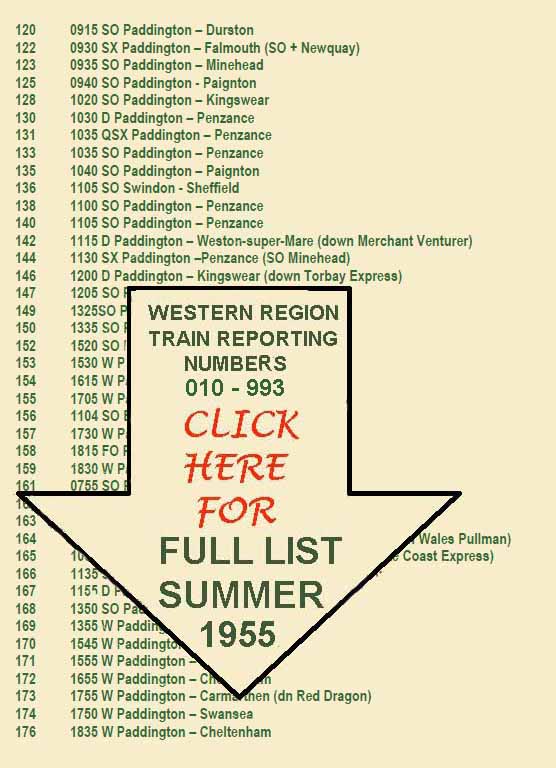
(Below) Passing Dainton Summit box in pouring rain, 'Hall' class No 5915 Trentham Hall of 83G Penzance shed, assists Stanier Pacific No 46237 City of Bristol with the up 'Cornish Riviera' plus a dynamometer on Wednesday 18 May 1955. The London Midland Region engine was on a short loan to the Western Region to assist in draughting and performance trials. Photo is by CHS Owen. 


(Above) Looking in excellent condition, 'Castle' class No 5099 Compton Castle brings 'The Edward Curran Companies Cardiff Works Outing 1955' special into Paddington on the penultimate day of the summer timetable, Saturday 17 September 1955. This headboard is certainly eye-catching, and with the loco being in such fine fettle the 145¼ mile trip bode well for the works outing to London. This photo was taken four months after 5099's Heavy Intermediate overhaul at Swindon on May 25, so by now, the loco was well renewed as one of Canton's finest Castles.
(Below) You'd be forgiven thinking this photograph has been duplicated, but there are subtle difference to NE Preedy's shot posted in the Summer 1954 section. Here Canton's 'Britannia' Class 7MT No 70029 Shooting Star and 'Castle' class No 5054 Earl of Ducie make a powerful pair as they enter Paddington on Maundy Thursday 7 April 1955, the day before Good Friday, with train 715, the Mon-Sat 6.30am ex-Swansea, which they have brought up together from Cardiff, aiming for a 10.50am arrival in the capital. In February the following year, the train was titled the 'Capitals United Express'. This pairing was a regular feature at busy weekends when many extra trains were run from London beforehand along with extra returning trains after the weekend. This is another example of Canton providing locos that will each haul their own train back to Cardiff. Photo is by Jack Craig, now in the Ray Hinton archive. 

(Above-Below) Cardiff Canton's 'Castle' class No 5006 Tregenna Castle and 'Britannia' 70029 Shooting Star restarts the down 'Red Dragon' after its obigatory 8pm stop at Badminton on Saturday 18 July 1953. It will run through the Severn Tunnel 20 miles ahead, and make its next stop at 8.47pm at Newport. (Below) Skirting the River Plym on Saturday 30 July 1955, Newton Abbot's 'Grange' class No 6836 Estevarney Grange and its solitary 'Britannia' stablemate No 70022 Tornado are approaching Plymouth on train 708, the 8.17am Carmarthen-Penzance; this was a Newton Abbot turn from Bristol to Plymouth, with 70022 replacing the engine from Wales at Bristol. The train is due to reach Penzance at 8.10pm, a long day for Carmarthen travellers. The return equivalent was the 10.20 SO Penzance-Swansea, due there at 8.10pm, hopefully not too late for passengers catching the westbound 'Red Dragon' due at Swansea at 10.38pm, and finally arriving at Carmarthen at 11.48pm - a lengthy 320-mile railway journey of a little over 13 hours, but a more restful one than a 1950's car journey. Photograph by SV Blencowe, Ref G2249.
(Below) This splendid shot by the late Jack Craig was taken during a period of just a few weeks when Stanier's Class 8 Pacific No 46237 City of Bristol was loaned for trials on some of the best Western Region express trains. On Saturday 23 April 1955, the loco is about to depart Paddington with the down 'Merchant Venturer' as far as Bristol Temple Meads. It returned to the capital later that day still carrying the same train number and headboard. As seen in an earlier photograph above, the LMR Pacific was also used on the Cornish Riviera, plus trains between Paddington and Wolverhampton. Many of Jack Craig's negatives are now in the Norman Preedy archive. 

(Above-Below) On Saturday 2 July 1955, Reading shed's 'Grange' class No 6834 Dummer Grange heads train 512, the up 10.40am SO Minehead - Paddington express, taking the Westbury bypass line opened in 1933 at Fairwood Junction. It is here where the original Great Western line via Swindon, Thingley Junction and Westbury, meets the 1933-built line which was realigned to favour the fast trains avoiding the town. Westwards from this junction, mileposts now differ from the post-1933 Direct Route mileage. The mileposts here continue to show 111 from Paddington going west, reflecting the original line, whereas it is now 97 miles on the Direct Route via Newbury to this point. (Below) On Saturday 23 July 1955, 'Hall' class No 6973 Bricklehampton Hall of Old Oak Common approaches Paddington with train number 123 signifying it is the stock for the 9.35am Paddington-Minehead. Once this has departed, 6973 will back out to Ranelagh Bridge and be used to haul another down holiday express from Paddington, possibly the 10.40am to Paignton. 

(Above) On Saturday 23 July 1955, Jack Craig photographed the arrival at Paddington of 'King' class No 6011 King James I with the 6.45am ex-Wolverhampton, due at 9.40am, ahead of the Swiss-built Brown Boveri Gas Turbine A1A-A1A locomotive No 18000, on train 450, the 7.00am ex-Weston-super-Mare, due at 10am.
(Below) On Saturday 3 September 1955 'Castle' class No 5075 Wellington is receiving attention on train 970 the Mon-Sat 8.56am Margate to Birkenhead at Birmingham Snow Hill. At this time, the 84K Chester loco will have come on at Reading or Oxford taking over from a Southern Region engine at that point. 5075 began life as Devizes Castle in August 1938 but in August 1940 5075 was one of 12 'Castles' Nos 5071-5082 to be renamed after the RAF and RNAS aircraft that served during WWII.

(Above-Below) BR Standard 'Britannia' Class &MT No 70025 Western Star of Canton shed emerges from the Severn Tunnel with the up Red Dragon on Saturday 17 September 1955. This was the first of five Britannias to be allocated to Canton for this and other express services in that same month. It became a Midland Region loco at Aston shed in September 1961. Photograph is by A Phipps. (Below) Sporting a Reading (81D) shedplate on the smokebox door, 'Castle' class No 5036 Lyonshall Castle arrives at Reading with the 7.35am Birkenhead-Margate express on Saturday 2 July 1955. The 'Castle' will be replaced by Southern Region loco, probably a 2-6-0, which will take the train on via Guildford and Redhill. There is plenty of coal in the tender, so 5036 will be used again this day for some other duty. Photo is by RA Panting. 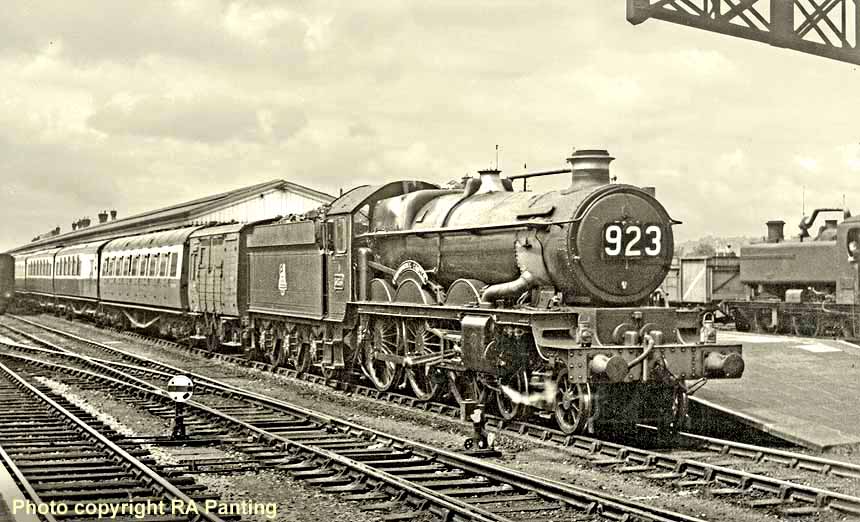
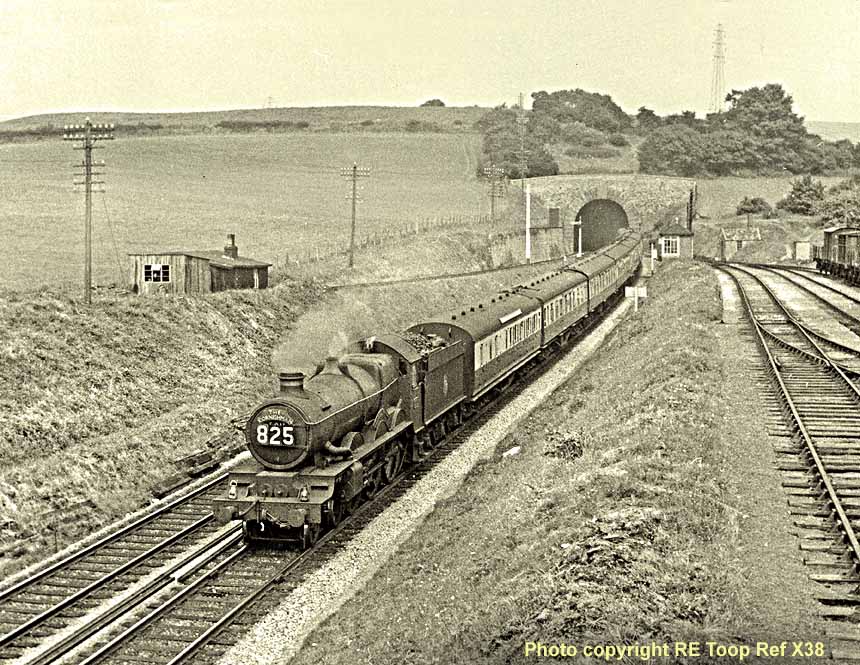
(Above) On Thursday 12 August 1955, 'Castle' class No 5011 Tintagel Castle descends from Dainton summit with the westbound 'Cornishman', next stop Plymouth North Road, due at 3.20pm. No 5011 had been a Newton Abbot engine since 1941 so being on this route was an everyday occurrence.
(Below) On Saturday 6 August 1955, Didcot shed's No 6952 Kimberley Hall is displaying an inappropriate train number, as it pilots No 4948 Northwick Hall on the 09.05 SO Swansea-Kingswear (actual train number 705) into Exeter St David's station. No 6952 had previously hauled train number 123, the 9.35am down Minehead train from Paddington to Taunton, where it was replaced by a 2-6-0 Mogul to take the train forward to Minehead; 4-6-0 engines were not allowed on the branches from Taunton to Devon's north coast. Meanwhile, after the arrival of the 9.05am ex-Swansea at Taunton, the next challenge facing train 705 was Wellington bank where the gradient rises to 1 in 80 at its most demanding section; this would require the assistance of one of Taunton's 2-6-2 tanks. However the 2-6-2Ts were mostly employed on the busy summer branch line workings around Somerset and North Devon, therefore the locomotives that came off the ex-PDN and ex-WPN extras for Minehead at Taunton were scheduled to pilot subsequent westbound trains to Exeter, where they had later return duties back to their home areas. 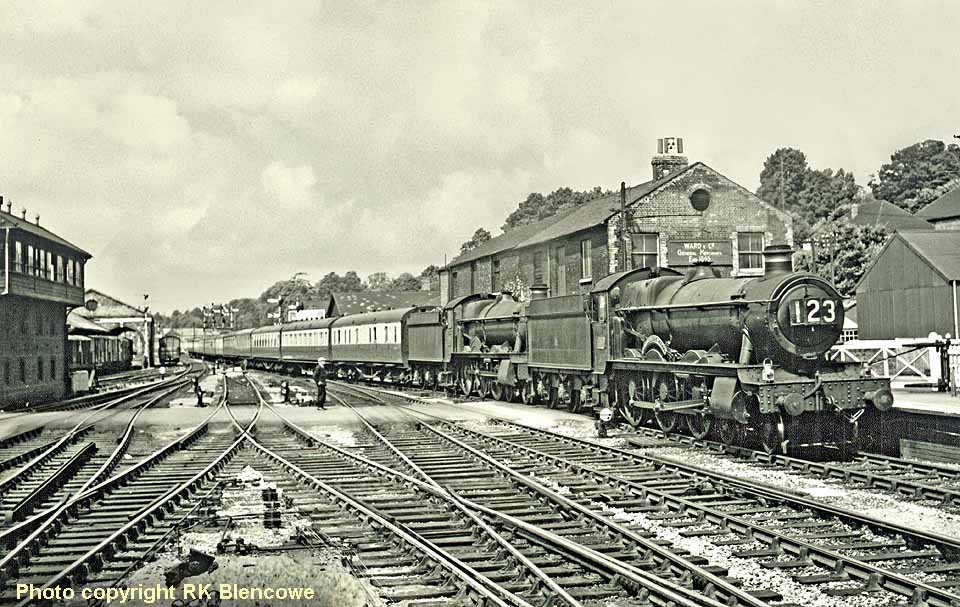
Winter 1955 - 19 September 1955 - 10 June 1956.
(Under Construction)
(Below) On Easter Tuesday 3 April 1956, 'Hall' class No 4924 Eydon Hall, of 82A Bristol Bath Road depot, hauls a Cardiff - Salisbury and beyond train over Keynsham water troughs, also known as Fox's Wood troughs, 4 miles after Bristol and 10 miles before Bath. The troughs were especially useful for trains not routed through Bristol Temple Meads, in particular freight traffic. 

(Above) 'Castle' class No 5066 Wardour Castle awaits departure from Paddington with a Cheltenham race special on Wednesday 7 March 1956; the special is accompanied by a group of Western Region top brass in their 'Sunday best' for a good reason; the headcode display of four lamps, three on the buffer beam and one on the smokebox door, signifying a Royal train; indeed all locomotives nominated for royal train duties were among the best in condition that 81A could offer. On 24 April 1956 No 5066 was renamed 'Sir Felix Pole' after the General Manager of the GWR 1921-1929. The nought in the '012' reporting number indicates the train doesn't appear in the public timetable; such trains were numbered 010 to 099, and those starting in the London division were numbered 010 to 039 at that time, later reduced to 029, all very esoteric. 
(Below) The 1956 FA Cup Final was contested between Manchester City and Birmingham City at Wembley Stadium on Saturday 5 May. Here RC Riley captured a bunch of happy Birmingham City supporters hanging out of carriage windows as 'Castle' class 5031 Totnes Castle of 84A Stafford Road shed, heads train 089 via the old Great Central link line to the North Eastern at Wembley Hill; the ensemble was photographed leaving the GW line at Northolt Junction, where the main WR line continues the ten miles to Greenford, Old Oak Common Junction and Paddington. Alas, although Birmingham City were the favourites that day, the fans will be rather crestfallen on the return journey as their club was beaten 3-1. Watched by a crowd of 100,000 and a television audience of five million, the match is best remembered for the heroics of Manchester City goalkeeper, Bert Trautmann, who continued playing despite breaking a bone in his neck following a collision with Birmingham City's Peter Murphy. Other extra trains operating from the Midlands that day were: 6011 King James I (84A) on train 082; 6828 Trellech Grange (84F, Stourbridge Junction) on train 083; 5912 Queen's Hall (84E Tyseley) on train 085; 5008 Raglan Castle (84A) on train 087 and 5927 Guild Hall (84E) on train 088. The locos will turn and get ready for their return journeys at Neasden ER depot. In addition, 6829 Burmington Grange of Newton Abbot was borrowed by one shed to haul extra train 354, also from the Midlands to Paddington. Photo is by RC Riley Ref 5936. The Transport Treasury superb archive of high-quality, hand-printed, traditional photographs from original negatives and digital images from transparencies have been entrusted to the company by railway and transport enthusiasts through the ages. Click here for link.
The Capitals United Express title was inaugurated on Monday 6 February 1956 and applied to the 6.30am ex Swansea, leaving Cardiff (by now appointed as the capital city of Wales) at 8.00am to reach Paddington for 10.50am. The return train left 3.55pm Paddington to reach Cardiff for 6.53pm and Swansea by 8.24pm.
Summer 1956 - 11 June 1956 - 16 September 1956.
The Cheltenham Spa Express title was inaugurated on 11 June 1956 (not 17 September as has been widely stated) and was given to the 8.00am ex-Cheltenham, stopping at Stroud from 8.39 for 2 minutes and at Kemble at 9.00am for 4 to reach Paddington at 10.35am. The return train left Paddington at 4.55pm, to reach Kemble at 6.32pm, Stroud at 6.53pm and Gloucester at 7.12pm. There is now a 6 minute halt while the train is reduced before it leaves to reach Cheltenham for 7.35pm. It is (only) on the 114 mile section between Paddington to Gloucester, that the train is its full length of 8 or 9 coaches. Reversal takes place at Gloucester where 4 or 5 coaches are added or detached, and instead of the Castle used to and from Paddington, the engine will be a 2-6-2T, often proudly showing the headboard for the 7 mile run.
(Below) This superb photograph by Norman Preedy of 'Castle' class No 5050 Earl of St Germans is alleged to have been taken on Thursday 2 August 1956, but Swindon records show that it was coupled with Collett tender No 2840 on that date, not a Hawksworth tender as seen here. Notwithstanding this discrepancy in detail, the Shrewsbury shed (84G) engine is in excellent condition as it approaches Parson's Tunnel with the 8.00am Plymouth-Crewe. A sunny day and a well turned out locomotive augurs well for the journey... 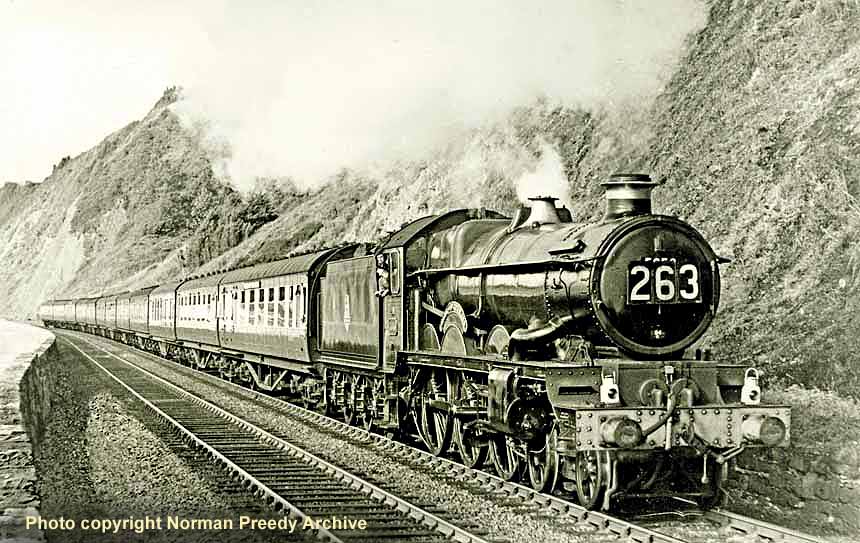

(Above) Having taken over the 9.10am Manchester (London Road) to Plymouth express (including a short portion for Paignton) at Shrewsbury, 'County' class No 1013 County of Dorset arrives at Bristol Temple Meads on Wednesday 25 July 1956. The locomotive will be replaced here by a Newton Abbot engine for the journey south. No 1013 was allocated to Shrewsbury shed between November 1951 and October 1956, prior to its transfer to Wolverhampton Stafford Road. ![]()
(Below) Memories of the named holiday trains on the Devon coast between Teignmouth and Dawlish are enough to make your pulse race! This fine shot of an immaculate 'Castle' class No 5074 Hampden hauling a set of chocolate and cream BR Mk 1 coaches on the up 'Torbay Express' was taken on 23 April 1957, the Tuesday after Easter. No 5074 was based at Old Oak Common shed (81A) which alternated with Newton Abbot shed (83A) in providing the locomotive for this train. The next stop will be Exeter at 12.40pm, followed by a non-stop run of 173½ miles to reach Paddington by 3.35pm. 

(Above) With the increase of extra trains drafted into the WR's summer timetable, it often became difficult for the operating department to find a suitable locomotive with a power classification relative to the task; either being too heavy or too light for the purpose. This rather grubby Class 5MT 'Hall' No 6941 Fillongley Hall will have its work cut out taking train 636, the up Riviera relief, 12.15pm ex-Plymouth, all the way to Paddington without a stop. The train ran only when traffic was especially heavy, so any functioning locomotive was pressed into service, which is clearly the case here. The train was timed to arrive at Paddington by 5.15pm, but with so many holiday extras, that would be a hard task.
(Below) 'Castle' class No 7025 Sudeley Castle of Old Oak Common, hauls the 2.15 FSX (or 1.58pm SO) Weston-super-Mare to Paddington which it will have taken on at Bristol Temple Meads. It has gathered speed by now entering Saltford station, 7 miles from Temple Meads, with just over 111 miles to go before arrival at Paddington at 5.30pm or soon after. 7025 was an 81A-based loco from new in August 1949 until August 1960 when, like many others, it was moved around as withdrawals started with the advent of diesels taking over their services. It was withdrawn in September 1964. Click HERE to visit the excellent Great Western Trust's website. Didcot is a must visit place for all WR fans; indeed why not get involved? The site contains full details..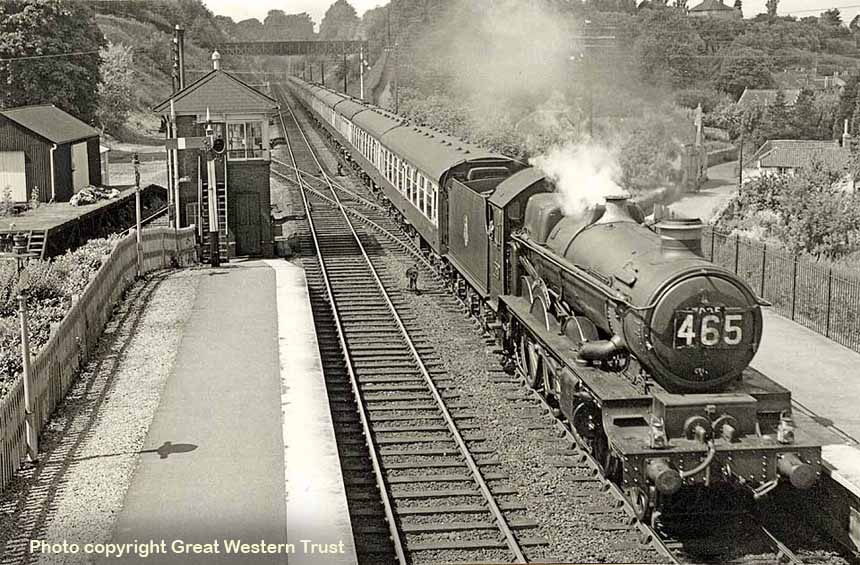

(Above-Below) 'Hall' class No 4971 Stanway Hall has exited Whiteball tunnel and is now passing Whiteball Siding Signal Box with the 09.05 SO Birkenhead-Plymouth express on Saturday 28 June 1958. 4971's home shed at this time was 83B Taunton, so it is very much on home territory. The train began usually with a portion for Cardiff, which was detached at Pontypool Road, with the train engine taken this further, while a new engine came on to haul the Devon portion, heading south using the North and West line via Hereford and the Severn tunnel. (Below) On Saturday 30 July 1956, 'Hall' class No 7927 Willington Hall, of Reading shed (81D), arrives at Paddington with train 385, the 11.12am SO from Weymouth, due at 3.30pm. This is a typical summer Saturday in the 1950s, with at least sixteen orderly spotters congregated at the platform end.

Winter 1956 - 17 September 1956 -16 June 1957.
The Royal Duchy title was given on Monday 28 January 1957 (and not some other date as has been stated) to the Mon-Sat 1.30pm Paddington-Penzance to reach Penzance at 9.20pm and the up train departing at 11.00am, reaching Paddington at 7.15pm. The down train was first hauled by 6000 King George V, the train conveniently being numbered 150. Train numbers in this period were mostly unchanged apart from the discontinuance of the Friday and Saturday Summer holiday trains.
(Below) 'Castle' class No 5069 Isambard Kingdom Brunel proudly takes the 'Royal Duchy' into Sonning Cutting. 5069 had been a Laira engine since 1954, acquired a double chimney in November 1958 and was withdrawn in February 1962. Motive power for this train this was varied: sometimes a King, often a Castle, more than once in the Summer of 1958 a 4700 class 2-8-0. On Saturday 19 July 1958; 6839 Hewell Grange (of Oxley - incredible) was used, and it was immaculate after an overhaul at Swindon Works. On other occasions, a Modified Hall was used, and in extremis, a Collett Hall. Back to this picture, 5069 had a Heavy Intermediate overhaul at Swindon Works in early 1957. I believe this photograph was taken soon after.
Staying with the subject of named trains, British Railways made great strides with the fitting of titled train headboards to the front of locomotives. The standard pattern keystone-shaped headboards had polished  Gill Sans lettering mounted on a black background (later red was adopted by the London Midland Region and blue by the Eastern Region). By 1956, however, the Western region took full advantage of BR's leniency towards the uniformity of headboard designs, including changes to the wording on the headboards too. For example, the WR's new 'Cornish Riviera Express' headboard included a cast crest which superceded the earlier (shorter) 'Cornish Riviera' title.
Gill Sans lettering mounted on a black background (later red was adopted by the London Midland Region and blue by the Eastern Region). By 1956, however, the Western region took full advantage of BR's leniency towards the uniformity of headboard designs, including changes to the wording on the headboards too. For example, the WR's new 'Cornish Riviera Express' headboard included a cast crest which superceded the earlier (shorter) 'Cornish Riviera' title.
 A wonderful chance to purchase a beautifully crafted piece of BR's Western Region's history from the Swindon factory went under the hammer at a Sheffield Railwayana Auction in June 2009. This wooden pattern (right) for the 'Cheltenham Spa Express' was used to cast the aluminium headboard, and came complete with the 'Shop Copy' of the original drawings and specifications first drawn in 1956 with further modifications dated 1960 and 1962. The drawings show details of all dimensions, sizes, lettering, motif, colouring and finishes. The wooden pattern measures 56" in width and 10" at the widest part, plus an additional 13½" for the City of Cheltenham crest. The name was conferred on the afternoon Cheltenham-Paddington train after World War Two. The express had the nickname 'Cheltenham Flyer' after various accelerations in the 1920s, but this was never officially used. It
A wonderful chance to purchase a beautifully crafted piece of BR's Western Region's history from the Swindon factory went under the hammer at a Sheffield Railwayana Auction in June 2009. This wooden pattern (right) for the 'Cheltenham Spa Express' was used to cast the aluminium headboard, and came complete with the 'Shop Copy' of the original drawings and specifications first drawn in 1956 with further modifications dated 1960 and 1962. The drawings show details of all dimensions, sizes, lettering, motif, colouring and finishes. The wooden pattern measures 56" in width and 10" at the widest part, plus an additional 13½" for the City of Cheltenham crest. The name was conferred on the afternoon Cheltenham-Paddington train after World War Two. The express had the nickname 'Cheltenham Flyer' after various accelerations in the 1920s, but this was never officially used. It  was for a time the fastest train in the world scheduled to run at over 70mph in 1932, covering the 77¼ miles between London and Swindon in just 65 minutes. The name lasted well into the 1970s.
was for a time the fastest train in the world scheduled to run at over 70mph in 1932, covering the 77¼ miles between London and Swindon in just 65 minutes. The name lasted well into the 1970s.
(Inset left) This wooden pattern for 'The Merchant Venturer' went under the hammer in June 2011. The headboard measures 39" width and 17½" at the widest, and features the Merchant Venturers of Bristol coat of arms along with the Latin quotation 'Indocilis Pauperium Pati' (A poor man to suffer ignorance). This pattern was used to make the mould to cast the aluminium headboard and came complete with the 'Shop Copy' of the original drawings and specifications dated 1960. The drawings show all details of dimensions, sizes, lettering, motif, colouring and finishes. The train was introduced by the Western Region in 1951 running between Paddington and Weston-Super-Mare via Bristol; the service was named after the Society of Merchant Venturers, a private entrepreneurial and charitable organisation that was formed in 13th century Bristol. The Society helped to 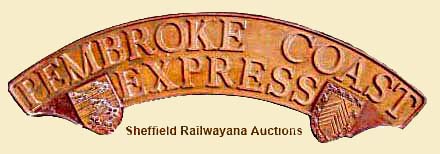 fund the building of Brunel's Clifton Suspension Bridge and also helped establish the Great Western Railway. The name continues to be used by First Great Western on the Paddington-Penzance via Bristol service.
fund the building of Brunel's Clifton Suspension Bridge and also helped establish the Great Western Railway. The name continues to be used by First Great Western on the Paddington-Penzance via Bristol service.
(Inset Right) This wooden pattern for 'The Pembroke Coast Express', measuring 52" in width, was used to cast the aluminium headboard. Like the previous lots it came complete with the 'Shop Copy' of the original drawings and specifications dated 1960. The drawings show all details of dimensions, sizes, lettering, motif, colouring and finishes. Introduced by the Western Region on 8 June 1953, the train was the 10.55 departure from Paddington for Pembroke Dock, with its last titled run on 7 September 1963. 
(Above) This style of BR headboard was used from the introduction of the titled train until the summer of 1958. Measuring 40" wide, the cast aluminium headboard in ex-loco condition, went under the hammer for £2,000 at a Great Central Railwayana Auction in March 2016. The back of the plate is marked 'Carmarthen 87G' plus it shows the names of other named trains with similar sized three-line headboards: The Flying  Scotsman, The Night Scotsman, The Hook & Day Continentals, The Scarborough Flyer, The Harrogate Sunday Pullman, The Heart of Midlothian, The William Shakespeare, The Merchant Venturer and Cambrian Coast Express.
Scotsman, The Night Scotsman, The Hook & Day Continentals, The Scarborough Flyer, The Harrogate Sunday Pullman, The Heart of Midlothian, The William Shakespeare, The Merchant Venturer and Cambrian Coast Express.
(Insert left) The name 'Capitals United' was originally used between 1956 and 1963 by British Railways Western Region for the service between London and Cardiff-Swansea to highlight the importance of the rail link between the capitals of England and Wales.
Summer 1957 - 17 June 1957 - 15 September 1957.
(Below) 'Castle' class No 4098 Kidwelly Castle had been a Newton Abbot (83A) engine for ten years when  this picture was taken on Saturday 20 July 1957. Having brought the down 'Torbay Express' to Kingswear, the loco was turned and its next job is this one, a Paignton to Newton Abbot empty stock train (ecs). Despite the changeover, 4098 keeps the down headboard aloft, while the lamp code has been altered from express to ecs. This was probably the second busiest Saturday of the Summer, with use made of every serviceable loco and carriage. Photo is by Cedric Owen.
this picture was taken on Saturday 20 July 1957. Having brought the down 'Torbay Express' to Kingswear, the loco was turned and its next job is this one, a Paignton to Newton Abbot empty stock train (ecs). Despite the changeover, 4098 keeps the down headboard aloft, while the lamp code has been altered from express to ecs. This was probably the second busiest Saturday of the Summer, with use made of every serviceable loco and carriage. Photo is by Cedric Owen. 

(Above) Although Cardiff Canton's 'Britannias' were the usual motive power on the prestigious titled trains between London and South Wales, their well-kept 'Castles' did appear from time to time. Having departed Paddington at 5.55pm, No 4073 Caerphilly Castle is passing Ealing Broadway with the down 'Red Dragon' on Friday 26 July 1957. I just wonder if a Britannia was 'relegated' to train 174 the 5.50pm down to Swansea.
 Please note - as mentioned at the top of the page, it is inevitable that some lists will require updating from time to time. The revisions may involve replacing the whole PDF or simply posting a revision note on this page. The latter is the case here.
Please note - as mentioned at the top of the page, it is inevitable that some lists will require updating from time to time. The revisions may involve replacing the whole PDF or simply posting a revision note on this page. The latter is the case here.
The revisions involve Train Reporting Numbers 421 & 422 as follows:
421 should read 23.37 FO Derby - Paignton.
422 should read 20.15 FO Keighley - Paignton.
(Below) Timed to pass Wellington in Somerset at 1.32 pm, Hall class No 4940 Ludford Hall has a load of 10 coaches on the drawbar as it tackles the 4 uphill miles to Whiteball box unaided with the 10.37am SO Cardiff - Paignton on Saturday 29 June 1957. No 4940 had been a Taunton loco for some years and would know this terrain rather well; it remained at 83B Taunton until it was withdrawn in November 1959. Photo is by RE Toop Ref No C48. 
(Below) Departing Llanelly at 8.10am, the morning sunshine glistens on Landore's highly polished 'Castle' class No 5039 Rhuddlan Castle in May 1958. Starting from Carmarthen at 7.30am, this is the first leg of the route of the 'Red Dragon' with another three stops still to go before its 8.40am arrival and reversal at Swansea (High Street) station for the next leg to Cardiff. Rhuddlan Castle is a suitable loco to be shedded at Landore at this time; indeed from 1952 it was based at a variety of Welsh sheds including Canton, Carmarthen, Llanelly, Goodwick and Cardiff East Dock before withdrawal came in June 1964. It had been one of the five Castles converted to oil burning in October 1946, converted back in August 1948. Photo is by Hugh Davies.


(Above) Introduced to traffic in August 1951, 'Britannia' Class 7MT No 70023 Venus was allocated initially to Old Oak Common (81A). Its next move came five years later in February 1957 when 70023 joined forces with 14 other Britannia class engines Nos 70015-70029 concentrated at Cardiff Canton (86C) for use on the London expresses, including the 'Capitals United Express'. On Maundy Thursday, 18 April 1957, with many extras running, 70023 is seen at Ruscombe, 29½ miles out from Paddington, between Maidenhead and Twyford, heading for Wales with train 171, the weekday 3.35pm to Neyland.![]()
(Below) The title 'Mayflower' was newly introduced in June 1957 for the 5.30pm Paddington-Plymouth, which ran the 142¾ miles to Taunton, to reach Exeter where a Torquay portion was detached, and Plymouth by 10pm. The up service departed Plymouth at 8.30am, calling at Newton Abbot where a Kingswear portion was added, also calling at Exeter and Taunton, and then slips a coach at Reading to reach Paddington by 1.25pm. Here 'King' Class 4-6-0 No 6002 King William 1V heads the 'up' 'Mayflower' into Reading on Maundy 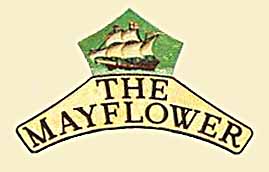 Thursday, 26 March 1959; the train is entering the up relief platform at Reading to stop. This train was one of the very few WR trains left which ran with a slip coach. On this Thursday, and on several Fridays in the peak summer season, the slipping was not done, the train stopped at Reading instead. This was to attach a pilot loco that had come from Reading shed, so as to give Paddington a loco and a crew for an extra holiday down train later in the day.
Thursday, 26 March 1959; the train is entering the up relief platform at Reading to stop. This train was one of the very few WR trains left which ran with a slip coach. On this Thursday, and on several Fridays in the peak summer season, the slipping was not done, the train stopped at Reading instead. This was to attach a pilot loco that had come from Reading shed, so as to give Paddington a loco and a crew for an extra holiday down train later in the day. 
Winter 1957 - 16 September 1957 - 8 June 1958.
(Under Construction)
On the first day of the winter 1957 timetable (Monday 16 September 1957) the long-running 7.45am Hereford-Paddington and the 4.45pm down service received the title 'Cathedrals Express'. The up train was a combination of two 4-car portions, the 7.45am from Hereford and 8.19am from Kidderminster, the latter containing a kitchen restaurant car; both portions were coupled on at Worcester Shrub Hill to make up an eight-coach train departing at 9am. The Worcester-Paddington leg was run each way by a Worcester-based 'Castle' class locomotive, with stops made at Evesham (9.15-9.18), Moreton-in-Marsh (9.39-9.42) and Oxford (10.18-10.21). Paddington was reached at 11.30am. The service ran Mondays-Saturdays only. The down service left Paddington at 4.45pm, reaching Oxford at 5.58 and Worcester Shrub Hill at 7.21, 120½ miles from  Paddington. The front Hereford portion then left to reach that city at 8.30pm, after a total journey of almost 150 miles.
Paddington. The front Hereford portion then left to reach that city at 8.30pm, after a total journey of almost 150 miles.
(Left) The Western Region's 'Cathedrals Express' headboard was a typically flamboyant affair; this weather-beaten example went under the hammer at a Great Western Railwayana Auction in May 2010...a visit to the GWRA's website is highly recommended HERE. The headboard was carried by both Worcester and Old Oak 'Castles' on the 'Cathedrals Express' between Paddington and the cathedral cities of Oxford, Worcester and Hereford. The titled train first appeared in the Western Region timetable on 16th September 1957.
(Below) 'Castle' class No 5042 Winchester Castle heads the up 'Cathedrals Express' past Kennington Junction, 2¼ miles south of Oxford. From 16 October 1958 until 17 December 1958, No 5042 was at Swindon Works having a Heavy Intermediate overhaul, including the moving of the forward lubricator from behind the steam pipe to in front of it; a regular occurrence when also acquiring a double chimney, but less often when remaining a single chimney, as here. The unit can be seen on the offside front of the frame. After a short spell back at Gloucester, 5042 moved to its new home shed of Worcester on 2 February 1959, and this was its base for exactly 365 days. Being an 85A loco, it was regularly to be seen on the Cathedrals Express, which became train number 022 as from 14 June 1959. Photo is by RHG Simpson.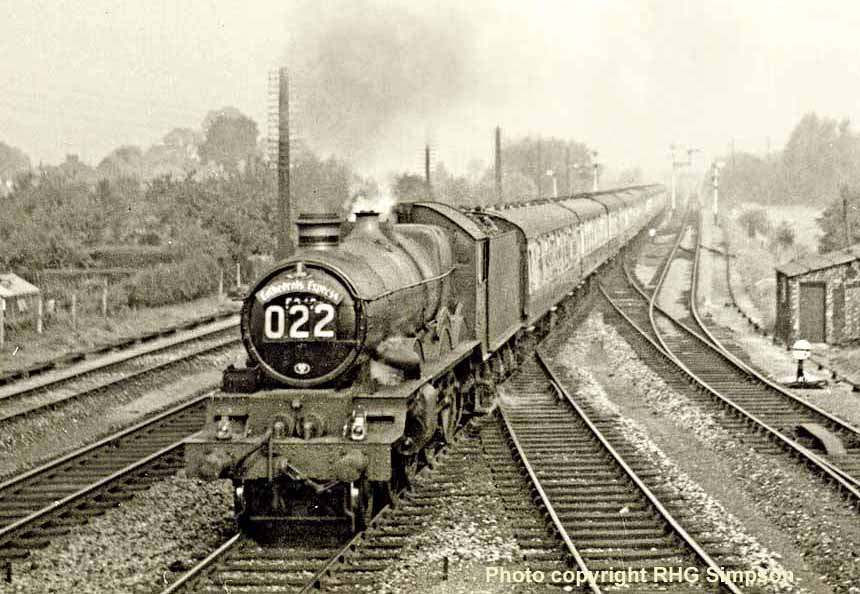

(Above-Below) As from 13 June 1960, the departure time for the up Cathedrals Express reverted to the former 7.45am ex-Hereford, and became train A22. Here 'Castle' class No 7007 Great Western passes Westbourne Park station 1¼ miles before Paddington on 7 November 1961. (Below) Passing Wolvercot Junction, north of Oxford, 'Castle' class 7013 Bristol Castle comes off the OWW (Oxford, Worcester and Wolverhampton, or the Old Worse and Worse) line at with the up 'Cathedrals Express' on 2 June 1962.
As from Monday 2 November 1959, due to the start of upgrading of the main line from Euston to the Midlands, less express trains were run on that route, therefore some additional services from Paddington were introduced to compensate. One effect was to cause the retiming of the Cathedrals Express. The up train ran 2 hours later, and the down train ran 2 hours earlier, enabling the same engine to be used on both. From this date, the up train became the 9.50am ex-Hereford, 10.55 Worcester and 12.12 Oxford to reach Paddington at 1.30pm The return service departed Paddington at 2.45 p.m, first stop Oxford at 3.56 and Worcester at 5.15pm. The 2 portions were then separated and the Hereford portion left to reach there at 6.17pm.
As from Monday 13 June 1960, the service returned to both its original up and down times. These essentially stayed the same until 11 September 1961 when the down service had a later start at 5.15pm from Paddington. The arrival of the up service varied at Paddington over the years between 11.25, 11.30 and 11.35 depending on the timetable. Also, during the steam era the train numbers were altered for both up and down  services as shown below...
services as shown below...
16 September 1957....up 360 - down 189.
9 June 1958................up 360 - down 194.
14 June 1959..............up 022 - down 930.
2 November 1959.......up 033 - down 928.
14 June 1960..............up A22 - down J46.
11 September 1961....up A22 - down T15.*
*At a date unknown to me as a result of Regional boundary changes, the down train reverted to J46. The up train always stayed as A22 from 14.6.60 onwards.
(Right) A GWR quad royal poster 'Cathedrals' by Fred Taylor went under the hammer for £420 at a Great Central Railwayana Auction in February 2015. Click HERE to visit the GCRA's website.
For the period 2 November 1959 to 12 June 1960, I have never seen 928 carried. The engine seemed always to retain the up run number 033 for the down run. From 14 June 1960, photographs of many down 'Cathedral Express' services carry the headboard wrongly. In these cases it is the loco for the up Cathedrals service returning, usually on the 1.45pm down, wrongly retaining both the headboard and up train number, which was always A22 from 14 June 1960 in steam days. The down service ex-Paddington, either 4.45pm or 5.15pm from 11 September 1961 was T15 or J46.
Photographs exist with steam locos showing the Cathedrals headboard and a number such as 051, A42, A43, A62 or A68. The prefix 'A' always meant a 'destination in the London district', in this case Paddington. So in these photos, the loco is returning to Worcester with the down Cathedrals Express, 4.45pm or 5.15pm but the 'A' code shows the previous duty of the loco. Photos exist of these trains with a Hall or Modified Hall on the front.
Of course such substitutes happened throughout the network but the usual haulage was a Worcester Castle, for which that shed had a high reputation for its upkeep. The number of carriages could also vary: there might be up to two additional carriages from Hereford-Worcester; also the other portion might not cease at Kidderminster but travel the further 7 miles to Stourbridge Junction, 142 miles from Paddington.
(Above-Below) A fine shot of the down Cathedrals Express entering Worcester Shrub Hill at about 7.45pm on a June evening in 1964. The J prefix applied as from the Summer 1960 timetable to trains destined beyond Worcester and Shrewsbury on WR metals. (Below) We finish this section with Rail Cameraman Richard Greenwood's splendid colour image of 'Castle' class No 7031 Cromwell's Castle resting beneath the cavernous roof at Paddington following arrival with the up 'Cathedrals Express' on Saturday 14 April 1962. 
(Below) Returning to the winter 1957 timetable, this is a shot of the rarely photographed train 666, the 3.35pm Friday Only Plymouth-Bristol Stapleton Road, sometimes extended to Cardiff; the ensemble is waiting to leave Newton Abbot station on Friday 27 May 1958. Train 665 used to be the number for the 12 noon from Penzance to Crewe, with carriages for Glasgow, but this was changed to 205 in 1953; its relief, 666, remained unchanged for the Plymouth-Bristol section of 130 miles. The 'Hall' class is No 4980 Wrottesley Hall of Bristol St Philip's Marsh shed, while the 0-6-0PT No 3606 in the bay platform is on a Teign Valley line train to Exeter.
Summer 1958 - 9 June 1958 - 14 September 1958.
Train numbers in this period from Paddington to all destinations were revised to new numbers that were only a few digits different to those that applied before. A few number changes were made to Friday/Saturday Summer holiday trains departing from the West Country. Elsewhere, numbers mostly stayed as before.
(Above) Sporting a Reading (81D) shedcode, 'Hall' class No 5956 Horsley Hall rests at Old Oak Common on Wednesday 23 July 1958. Barely legible on the smokebox door is a chalked 'No 1' which indicates one of the early Saturday morning empty stock trains into Paddington from the London division sheds to augment the busy summer timetable. Numbered 1 to 5, the trains consisted of stock, a loco and crew to assist with the heavy increase in weekend traffic. The 'No 1' has stayed there since Saturday 19th. 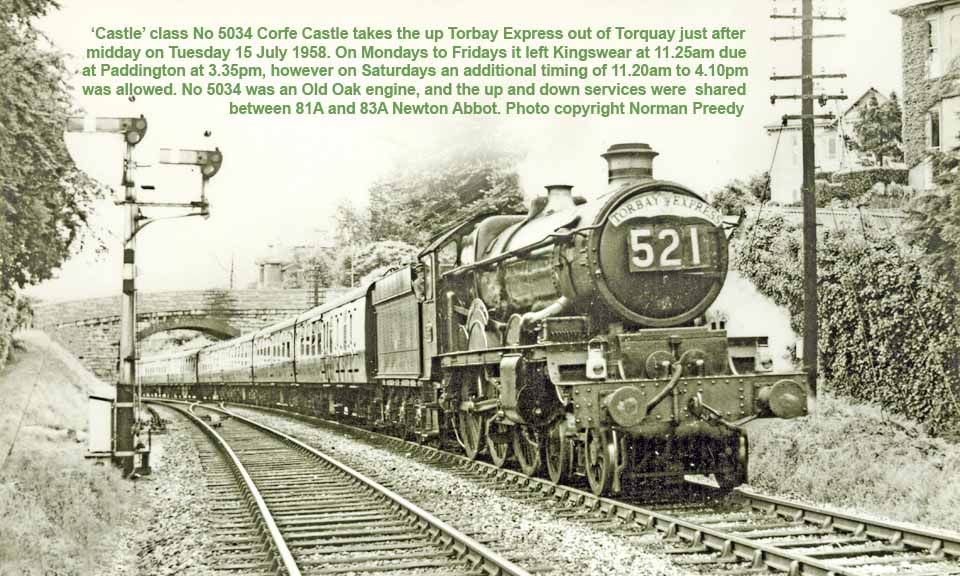
(Below) Emerging from Swindon Works in July 1927, 'King' class No 6005 King George II spent most of its life at Wolverhampton Stafford Road shed. In the summer of 1958, 6005 enters Paddington with an excursion from Wolverhampton; note the double chimney and slotted bogie. The overall design of the 'King' bogie was a characteristic feature of the Class 8Ps; the large cylinders led to clearance problems on curves but this was overcome by designing the bogie frame so that the rear axle boxes were inside the frames and the front ones outside. However, the reason for the slotted bogie remains something of an enigma. On page 17 of Bill Peto's excellent 'Register of GWR Locomotives', published by Irwell Press - widely regarded by GWR enthusiasts as the 'Bible' - is the following comment - 'One bogie had a slotted front cross-stay. Despite enquiries it has not proved possible to determine the purpose of this feature - it would hardly have been intended as a weight-saving measure for it would have had a negligible effect, and it is unlikely that it was done to aid the flow of air around the inside cylinders as cooling would not have been desirable. A stab in the dark is that, as the bogie was apparently, first fitted to No 6004 - the first new King to be completed after the Midgham incident - it might have had something to do with the balance of the bogie. This, it must be repeated, is only a guess - informed enlightenment would be positively welcome. It is, unfortunately impossible at this stage to provide a definitive list of which Kings used the slotted bogie 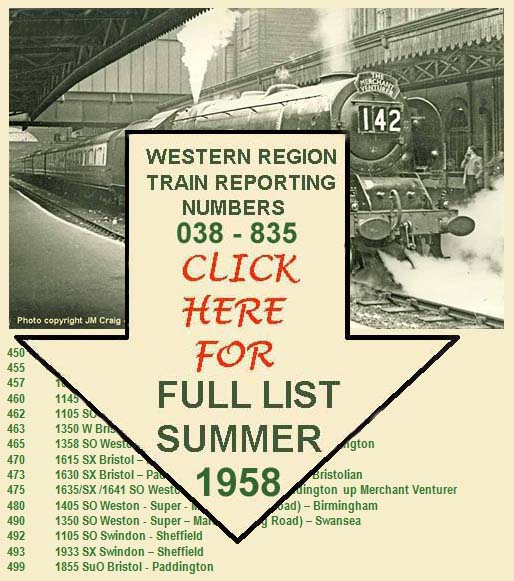 and when.
and when.
Combining reports in the RCTS Locomotives of the GWR and photographic evidence, it is possible to offer only the following scant details:
6004 seems to have had the bogie in 1927.
6000 in July 1931.
6023 in 1935 and maybe through to 1938 or later.
6018 either to or from September 1948.
6028 (unconfirmed) possibly circa 1950.
6014 in 1954/55.
6024 in 1957, possibly 6000 also in 1957.
6005 seemingly from 1958 to 1961.
6021 in 1962...'
I'm sure the above will be of interest to the discernible railway modeller. For the record, No 6005 was withdrawn from service at Old Oak Common shed in November 1962 and scrapped at J Cashmore of Great Bridge.


(Above) Prior to departure from Exeter St David's with the 1.55pm SO Paignton-Wolverhampton on Saturday 26 July 1958, much artwork has been applied to the smokebox door to emphasise the destination of 'Hall' class No 6936 Breccles Hall. The locomotive is sporting a Bristol (Bath Road) shedcode (82A) following its move from 82B earlier that month; however not long after No 6936 was transferred to Cardiff Canton 86C.
(Below) Taken at about 7.30pm this is 'Castle' class No 4097 Kenilworth Castle, now with a double chimney, racing past Reading on the 6.55pm Paddington-Fishguard Harbour, which it will take to Swansea, where 4097 will hand over to another engine, and then go to its home shed of Landore for servicing. Train number 182 applied only to this service in the 1958 Summer timetable, so this picture was taken between 9 June and 14 September 1958 by the renowned railway photographer, Maurice Earley. 
(Below) 'Castle' class No 7037 Swindon is sporting a Swindon (82C) shedplate on the smokebox door, albeit the photo was taken after the engine had been reallocated to Cardiff Canton (86C) in early June 1959. The actual date of the picture can be narrowed down to the couple of weeks before the commencement of the 1959 Summer timetable; the reporting number 452 (11.52am Manchester-Plymouth) lost its currency on 15 June. This train was a Canton turn back from Shrewsbury off the 8.55am Cardiff-Manchester which 7037 worked a few times during its month-long residency at Cardiff. Alas its short stay at Canton was not long enough for the cleaners to get their teeth into it! No 7037 returned to 82C in July looking as grubby as it did when it left there. My thanks to Richard Woodley for answering my query regarding the use of a Swindon engine on this duty.
Winter 1958 - 15 September 1958 - 14 June 1959.
A total revision of all train numbers throughout the Western Region began with this timetable. The new system was completely the reverse of what applied before, in that the first digit now applied to the destination of the train: In brief, irrespective of their starting point, numbers 001 to 199 applied to trains to the London District, i.e. Paddington. The 200 series applied to those terminating in the Bristol District, the 300 series to those terminating in the Exeter District, the 400 series to those in the Plymouth District, the 500 series to Cheltenham, from 600 onwards to Cardiff, from 700 onwards to places in South Wales, from 800 to the Midlands. The 900 series was split between those to Hereford, and those beyond the Midlands in the north-west.

(Above) Approaching Stoneycombe Quarry on the climb of Dainton Bank, an immaculate 'County' class 1010 County of Caernarvon, a long-time resident of Laira shed throughout the 1950s, heads the 9.30am  Paddington-Plymouth during the Winter 1958 timetable. No 1010 obtained a double chimney in January 1957.
Paddington-Plymouth during the Winter 1958 timetable. No 1010 obtained a double chimney in January 1957.
(Below) An impeccable 5013 Abergavenny Castle of Landore shed awaits departure from Swansea High Street station with the 3.45pm 'Pembroke Coast Express', due at Paddington at 7.45pm. Although the precise date is not known, one can glean from the photo that 074 was the train reporting number for the up 'Pembroke Coast Express' during the Winter 1958-59 timetable, plus 5013 emerged from Swindon Works after a Heavy Intermediate overhaul in October 1958, so my guess is the photograph was taken soon after it had been run in and returned to Landore. 
Summer 1959 - 15 June 1959 - 13 September 1959.
(Under Construction) 
(Below) Newton Abbot's 'Castle' class No 5003 Lulworth Castle hurries the 9.05am Paignton - Manchester (London Road) along the sea wall at Dawlish on Saturday 15 August 1959. Doubtless being a holiday Saturday, it will take quite a time for the returning holidaymakers to reach their destination, but the WR will do their best, with a well turned out and good looking engine along well kept track.
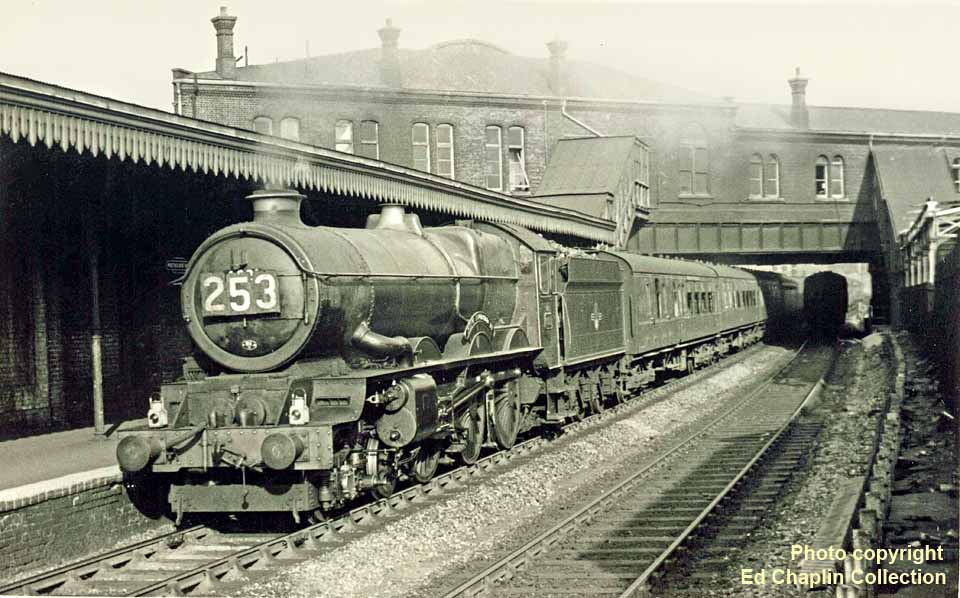
(Above) In the Summer 1959 timetable, 6021 King Richard II hauls train 253, the 6pm to Weymouth out of Paddington, this (unique to me) photo being taken near Westbourne Park, with its first stop being at Newbury 52 miles ahead. Disappearing on the up empty stock carriage line is a later departure. 6021 will come off the train at Westbury, and return on the 6.35pm Weymouth milk train that will stop at Westbury 10.05pm - 10.25pm to change engine. 6021 will then take the Trowbridge route and call at Swindon, Didcot and Reading before reaching Paddington at 1.30am, the only up milk train that terminated at Paddington. Those milk trains were very heavy, 16 loaded milk tanks made 448 tons, plus at least one van.
The principle behind the revision introduced for the Winter 1958 timetable was extended to include all the holiday trains, and to assign numbers to trains that hitherto had been numbered. However, it was a complete revision numerically of all trains and so it was the most extensive allocation of train numbers than ever before, with some regular trains formerly not being numbered, now did acquire one, and it was this approach that applied to all train numbers for all subsequent timetables.Some of the trains listed ran on other days to those shown when traffic required, and may or may not have been numbered then.
The LMR trains to and from Weston-super-Mare ran via Bristol, for those 19 miles, used a London Midland Region loco and a London Midland Region train number, and those trains are not shown here. On Saturdays, WR and LMR trains terminating and starting at Weston-super-Mare used Locking Road station and not the through station ('General').
These numbers applied from the start of the Summer Timetable 1959, Monday 15 June 1959 and ended one year later on Sunday 12 June 1960. Note that almost all the SO trains ran only in the Summer 1959 holiday period, and then on various dates within that period, and not throughout; they were called 'dated trains'.
The Winter 1959 timetable began Monday 14 September and all SO holiday extras then ceased or had ceased before then. Also ceasing were the many Friday Night trains to Devon and Cornwall, which took holidaymakers on long journeys, so that they could be at their resort during Saturday and not miss a day's holiday.
Saturday 26 September 1959 was the last day that boat trains ran to and from Paddington to Weymouth; in the future London trains used Waterloo only. That means the Weymouth Quay trains listed here, ceased on that date, while the Weymouth Town ones continued. As from Monday 2 November 1959, some extra trains were run between Paddington and the Midlands. The reason for this was the London Midland Region line to and from Euston began to suffer restrictions due to work starting on electrifying the West Coast Main Line. Those changes I am aware of, are shown at the end of this listing.
In the Spring of 1960, in the approach to the Whitsun weekend (Whit Sunday 1960 was 5 June) a few of the Summer 1959 holiday trains ran again, before the Summer 1960 timetable began. Some others ran with formerly unused numbers, noted at the end of this listing.
As in all previous years, some trains shown as terminating at Plymouth or Penzance, also contained a portion for the Kingswear branch which was detached at Exeter or Newton Abbot, and then taken onwards, often with a few additional carriages, as a semi-fast train. The reverse procedure was used on the return journeys. The existence of those trains with this branch portion is not noted in these lists.
D - Daily (i.e. Mon - Sat and Sun), every day of the year.
FN - Friday night, i.e. overnight and reaches destination on Saturday.
FO - Friday only.
FSO - Friday and Saturday only.
FSX - Monday - Thursday only.
MFO - Monday and Friday only.
MX - Except Monday (i.e Tue - Sun).
Q - Ran as required.
SN - Saturday night i.e. overnight and reached destination on Sunday.
SO - Saturday only.
SuO - Sunday only (including overnight and reached destination on Monday.
SX - Saturday excepted (i.e. Mon - Fri).
W - Every Weekday (i.e. Mon - Sat).
Unless otherwise noted, 'Birmingham' means Snow Hill, 'Bristol' means Temple Meads, and 'Manchester' means London Road, later Piccadilly.
A few trains started or terminated at Birmingham Moor Street, Bristol Stapleton Road, and the other Manchester stations, Victoria and Exchange, and these are specifically noted.
All trains shown as terminating Swansea, means High Street Station.
Note that trains to and from the London Midland Region or beyond into the Eastern or Scottish Regions used the MR's Reporting Numbers, with a London Midland Region loco for the Midland part of their journeys. Only the WR numbers of such trains when on WR territory are therefore shown.
(Above) On 26 June 1959 'King' class No 6013 King Henry VIII of Laira shed heads through Tiverton Junction with train 438, the Friday 12.05pm ex-Paddington. This train carried no public passengers and its purpose was to bring down dining and restaurant cars for the up trains from Cornwall that contained such a car the following day. The loco went as far as Plymouth when a West Country loco took it forward to Truro where the cars were separated and shunted into the correct position with the rest of the passenger coaches of the next day's trains. The train was unique to Plymouth with an A class lamp code, a train number, and no paying passengers. Photo is by J Davenport, Initial Photographics...a contact address can be found at the bottom of the page.
(Above) A splendid photograph of 'Castle' class No 5029 Nunney Castle hauling the 9.30am Paddington-Falmouth up the last few yards of Dainton bank before the tunnel on Friday 22 April 1960. Built in May 1934, the now-preserved 5029 spent most of its working life working from Old Oak Common. The engine moved to Worcester in 1958, followed by spells at Newton Abbot and Laira before a final transfer in 1962 to Cardiff East Dock from where it was withdrawn in December the following year. Sold for scrap to Woodham Brothers in June 1964, the loco languished at the Barry Scrapyard for a further 12 years before being rescued in May 1976. Photo is by BWL Brooksbank, Initial Photographics.
(Below) On Saturday 18 July 1959, 'Castle' class No 5065 Newport Castle of Old Oak Common (81A) hits about 60 mph as it takes the up 'Cambrian Coast Express' through Knowle and Dorridge station, 11 miles out of Birmingham on its way to Leamington Spa and Paddington, exactly 100 miles still to go. The incorrect train reporting number 911 is yet another case of mistaken identity, for No 5065 had taken the down 'Cambrian Coast Express' earlier that day but retained the same number for its return working to the capital.


(Above) A grimy 'Hall' class No 4901 Adderley Hall of Stafford Road shed (84A) makes a spirited exit from Banbury with the 08.43am Wolverhampton to Portsmouth on Saturday 1 August 1959. This run-down 'Hall' is a far cry from spick and span 'King' and 'Castle' class locomotives that previously carried '130' on their train reporting frames. This number was displayed between June 1951 and June 1958 by locomotives hauling arguably one of Britain's most famous trains, the down 'Cornish Riviera Express'. ![]()
(Inset) Despite the fact the locomotive is carrying the incorrect train number 204, Old Oak Common's 'King' class No 6003 King George IV is about to depart from Paddington with the down 'Cornish Riviera Express' on Tuesday 16 June 1959. I recently contacted Richard Woodley, author of 'The Day of the Holiday Express' published by Ian Allan Ltd, to congratulate him on his excellent book and query some photos I had of WR steam, including this one. Richard  kindly replied - 'Two days after the introduction of the 100 minute 'Bristolian' schedule, one of the two diesels destined to haul Tuesday's down train from Paddington failed on its way up overnight Monday. Old Oak Common was ready to turn out No 6003 for the 'Bristolian' with the correct 204 number but higher authority countermanded this. The result can be seen here; the down 'Bristolian' number appeared on the down 'Cornish Riviera Express'! The photo is by Andrew Ingram.
kindly replied - 'Two days after the introduction of the 100 minute 'Bristolian' schedule, one of the two diesels destined to haul Tuesday's down train from Paddington failed on its way up overnight Monday. Old Oak Common was ready to turn out No 6003 for the 'Bristolian' with the correct 204 number but higher authority countermanded this. The result can be seen here; the down 'Bristolian' number appeared on the down 'Cornish Riviera Express'! The photo is by Andrew Ingram.
(Below) British Railway Civil Engineers have always been influenced by the Sunday timetable as the infrequency of trains allows them to gain almost uninterrupted possession of running lines. This was the case at Dawlish on Sunday 21 June 1959, when engineering work on the Devon coast line led to single-line working on the 'up' line. Here 'King' class No 6007 King William III, a Laira loco for just a few weeks, approaches Dawlish at a sedate pace with the Sunday down 'Cornish Riviera Express'; the imposition of a speed limit at the this Devon coastal resort was hardly an encumbrance for passengers, rather it gave them chance to enjoy the splendid sea views along this lovely stretch of main line between Exeter and Newton Abbot. 
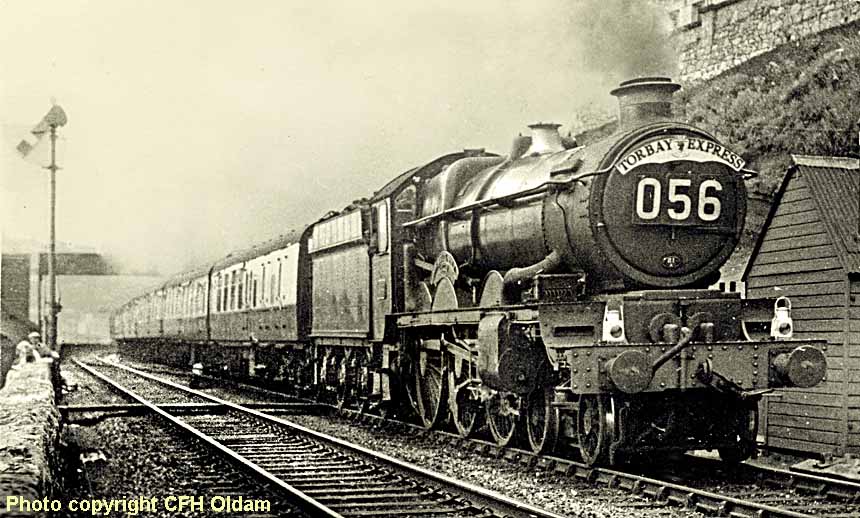
(Above-Below) In the opposite direction, 'Castle' class No 5066 Sir Felix Pole heads the up 'Torbay Express', now train 056 along the sea wall at Dawlish on Tuesday 23 June 1959, just eight days into the Summer 1959 timetable. But there was no change in timings for this 11.20am ex-Kingswear express Mondays to Saturdays. (Below) Another 'Castle' class No 4098 Kidwelly Castle, a Newton Abbot engine since 1947, hauls the down 'Torbay Express' on the climb from Goodrington Sands station to Churston and Kingswear, arriving there at 4.10pm; a challenging task on a busy holiday Saturday. The photo was taken on 23 August 1959 by Tony Wright. 


(Above) On Saturday 4 July 1959, Shrewsbury's BR Standard Class 5 No 73096 visited Devon with train 328, the 9.05am SO Swansea-Kingswear; the loco is seen here returning north at Aller Junction with the 5.35pm Kingswear-Taunton semi-fast. The Western Region had a few Standard Class 5 locos, which were used on both passenger and freight work, then very much a domain of the ex-GWR Class 5MT 'Granges' and 'Halls'. The Shrewsbury locos were more often to be found on the Central Wales line from Craven Arms to Swansea. This WR train has been depicted in the books 'Branch Lines of Devon' and 'Rails to the Sea' with the wrong date of 'May 1959'. The date I give here is correct; the photo is by Cedric Owen.
(Below) Sporting a train reporting number 007, signifying the 7.00am ex-Weston-super-Mare, Old Oak Common's 'King' class No 6024 King Edward I is reversing out of Paddington to be turned at Ranelagh Bridge. What a shame it was not one of the two King James! The loco came on at Bristol, and the Bath Road fitters have cleverly slung the number frame at a lower position so as to show the loco number, well done! This is another of JM Craig's splendid photographs, now in Ray Hinton's archives. 

(Above) On Saturday 8 August 1959, Class 9F No 92232 of Severn Tunnel Junction (86E), brings the 8.05am SO Cardiff-Kingswear past Hollacombe gas works, just south of Torquay. The 9Fs were an invaluable extra source of power for the Western Region's holiday extras during the busy summer months; indeed contrary to what one might expect of a heavy freight locomotive the 9F's 2-10-0 wheel arrangement did not severely limit its route availability. Having said that, the Kingswear branch from Aller Junction had been upgraded many years before to allow 'King' class locos to operate, including the final six miles of single line to the branch terminus at Kingswear. Photo is by Cedric Owen.
(Below) On Saturday 25 July 1959, Class 9F No 92206 of 82B St. Phillip's Marsh shed has brought in train 042, the 10.40am ex-Minehead, which it took on at Taunton during the loco changeover from 11.37 to 11.47am. Following its arrival in the capital, due at 2.40pm, the 9F is photographed at rest at Paddington's platform 7. Photo is by RK Blencowe ref 30476.

(Above) Cowley Bridge Junction is where the SR line from Okehampton joins the Great Western main line 1¼ miles before Exeter. The down train is the 7.30am Paddington to Kingswear via Bristol, where 'Castle' class No 7014 Caerhays Castle, a Bath Road loco at this time, replaced the loco from Paddington. The date is Friday 26 June 1959, the day before the holiday traffic really increased. No 7014 had a double chimney fitted in February, and the loco was one of five fitted with a Davies & Metcalfe mechanical lubricator for the front right had side of the boiler, albeit not visible in this shot. Being one of the later builds (July 1948) No 7014 was finally withdrawn in February 1965
(Above) A second shot of train 438, the Friday 12.05pm ex-Paddington empty diners, this time captured by Norman Preedy passing through Newton Abbot behind 'King' class No 6015 King Richard III on 3 July 1959; the restaurant cars are being delivered to Truro where they will be separated and shunted into position among the next day's up trains from Cornwall. The locomotive displays an 'A' class lamp code denoting an empty coaching stock train timed at express passenger train speed. On further study of the FO 12.05 ex-Paddington empty diners to Plymouth, the other locos (all but two of 81A) that worked this train on other Summer Fridays are as follows: 21.8.53 - 6973; 3.9.54 - 6978 (of 83D Laira); 18.7.58 - 7909 (of 82D Westbury); 15.8.58 - 5098; 10.7.59 - 7031; 24.7.59 - 5035; 31.7.59 - 5923; 14.8.59 - 92230; 21.8.59 - 5929; 29.7.60 - 7017 carrying C38, which was correct, and 11.8.61 - 4075. There were a 100 or so others at other dates but too numerous to list here. Some of the diners came off at Plymouth and were reserved for some up (next day) Saturday trains to which they were added, while a new engine, such as a Castle, Hall or Grange took the remaining diners on to Truro for further separations for the next day's Falmouth, Newquay, and other up trains. So using a 'King' for the Paddington - Plymouth part might be rare.
(Below) From 14 June 1959, the up 'Cathedrals Express' was numbered 022. Here 'Hall' class No 7920 Coney Hall of Worcester shed makes a late arrival at Paddington on a Summer Saturday in 1959. Train 022 was due to leave Hereford at 7.45am and Worcester at 9.00am to reach Paddington for 11.30am. Backing out is Bath Road's 'Castle' class No 5062 Earl of Shaftesbury off 021, the 8.20 am ex-Weston-super-Mare, which it will have hauled as a 9.00am departure from Bristol Temple Meads, due to arrive at Paddington at 11.20am. So it seems 7920 is somewhat late this day.

(Above) The down 'Cathedrals Express', so named in 1957, left Paddington at 4.45pm and in the summer of 1959, until 2 November 1959 became train 930, as seen here at Oxford at 6pm, hauled by 'Castle' class No 5071 Spitfire on Saturday 18 July 1959. There were eight more stops before it reached Hereford at 8.30pm. The post-2nd November winter timetable (see below) included a revision to several West Midlands trains whereupon the 'Cathedrals Express' was re-timed to leave Paddington at 2.45pm ultimately reaching Hereford at 6.17pm. However when the next timetable became effective on 13 June 1960, the down train reverted to its former schedule departing Paddington at 4.45pm. (Left-Below) This cabside numberplate from 'Castle' class No 5075 Wellington went under the hammer for £3,000 at a GW Railwayana Auction in November 2014. No 5075 was withdrawn from traffic at Bristol St Philip's Marsh shed in September 1962 and scrapped at Cashmore's of Newport. (Below) Brunel's famous Royal Albert Bridge provides a splendid backdrop to this shot of 'Castle' class No 5075 Wellington at the head of a down excursion from Exeter in July 1959. The ensemble is entering Saltash station, where the single line device - handed over a few minutes earlier on the Devon side of the River Tamar - is now being passed to the porter at Saltash station on the Cornish side. When new in August 1938, No 5075 spent most of its working life based at Stafford Road (84A) but moved to Laira (83D) in April 1958, Exeter (83C) in June 1959, then Neath (87A) in July 1961. Originally named Devizes Castle, No 5075 was one of twelve 'Castles' Nos 5071-5082 to be renamed in the autumn of 1940 to commemorate the RAF aircraft that served during WWII; No 5075 was named after the famous Vickers Wellington bomber.
(Left-Below) This cabside numberplate from 'Castle' class No 5075 Wellington went under the hammer for £3,000 at a GW Railwayana Auction in November 2014. No 5075 was withdrawn from traffic at Bristol St Philip's Marsh shed in September 1962 and scrapped at Cashmore's of Newport. (Below) Brunel's famous Royal Albert Bridge provides a splendid backdrop to this shot of 'Castle' class No 5075 Wellington at the head of a down excursion from Exeter in July 1959. The ensemble is entering Saltash station, where the single line device - handed over a few minutes earlier on the Devon side of the River Tamar - is now being passed to the porter at Saltash station on the Cornish side. When new in August 1938, No 5075 spent most of its working life based at Stafford Road (84A) but moved to Laira (83D) in April 1958, Exeter (83C) in June 1959, then Neath (87A) in July 1961. Originally named Devizes Castle, No 5075 was one of twelve 'Castles' Nos 5071-5082 to be renamed in the autumn of 1940 to commemorate the RAF aircraft that served during WWII; No 5075 was named after the famous Vickers Wellington bomber.
(Initial) Winter 1959 - 14 September 1959 - 1 November 1959.
The train numbers for this period were as for the Summer 1959 season except that there were no Saturday holiday extras, save for a few over-runs in September, but a major change was in the offing.
(Subsequent) Winter 1959 - 2 November 1959 - 12 June 1960.
(Under Construction)
(Below) This fine study of 'Castle' class No 5039 Rhuddlan Castle, with train No 049 displayed on the smokebox, was taken at Shrewsbury prior to taking the up Cambrian Coast Express. No 5039 was allocated to 85A Worcester for an eight week period between 30 December 1959 and 18 February 1960. During this time there was a Worcester diagram that provided the loco to take the Shrewsbury - Wolverhampton stage of the London-bound Cambrian Coast Express, which is what 5039 was called upon to do here. 5039 had been an 87E Landore engine from June 1957 until the eight weeks mentioned above, but after this period it returned to Landore. While this Worcester diagram was in effect, several photographs were taken of other 85A locos carrying the Cambrian Coast Express headboard and number 049, including Nos 6989, 7005 and 7007, to name just three. Photo is by SV Blencowe, Neg No 10972.
The Winter 1959 timetable numbers continued except that as from today, changes and additions were made to services between the north-west and the Midlands and Paddington, and between Hereford and Paddington. This was as a result of certain Midland Region services to and from Euston ceasing, due to the start of work to electrify that line. To compensate for this, extra WR trains were run between Paddington and the Midlands. Those known to me, I am sure there were more, are listed now. In addition, the timings for both up and down Cathedrals Express trains between Hereford and Paddington were altered, until this timetable was replaced by the Summer 1960 timetable, and both the up and down train reverted to the original timings. For those 7½ months, that enabled the loco on the up train to be turned at Ranelagh Bridge and used also for the down train, with the titled train nameplate left fitted. One result was that the new number of the up train, 033 on the smokebox door, was left unchanged, giving rise to photograph caption errors.
For the up Worcester & Hereford trains:
022 07.45 W Hereford - Paddington continued but was not titled the Cathedrals Express
033 09.50 W Hereford - Paddington; existing train now named the up Cathedrals Express, due PDN 13.30.
The down Hereford departures from Paddington were retimed to give a better interval service thus:
925 retimed from 09.45 to 09.15
926 retimed from 11.45 to 10.45
927 retimed from 13.45 to 12.45
New down train 928 1445 W Paddington - Hereford, became the down Cathedrals Express, but the train appeared to be 033 as the loco was that off train 033, as explained above.
930 remained unchanged @ 16.45 W Paddington - Hereford but was not titled the Cathedrals Express.
931 remained unchanged at 18.45 W Paddington - Hereford.
New down train number (if any) unknown 21.45 W Paddington - Hereford.
For trains between Paddington and Wolverhampton and beyond:
034 07.35 SX Birkenhead - Paddington, new up train.
049 07.40 SX Pwllheli (0945 Aberystwyth) - Paddington became the up Cambrian Coast Express.
071 11.45 SX Aberystwyth (0945 Pwllheli) - Paddington ran but was not titled the Cambrian Coast Express. 077 16.20 SX Wolverhampton - Paddington, new up train.
800 16.34 SX Paddington - Wolverhampton, existing down semi-fast train now numbered
844 15.10 SX Paddington - Wolverhampton, new down train.
(Below) This is not the 'Cathedrals Express'! As from 2 November 1959, train 022 was retimed to depart Worcester at 8.55am, but it was no longer the 'Cathedrals Express'. Here a pair of 'Hall' class 4-6-0s Nos 7928 Wolf Hall and 5917 Guild Hall, both Worcester shed engines, are working the 'new' 022 out of Worcester for Paddington on Tuesday 3 May 1960, just 2 weeks after Easter. The up Cathedrals Express departure from 2 November 1959 became the 9.50am ex-Hereford and 10.55am ex-Worcester, timed to reach Paddington at 1.30pm. 

(Above) Here is train 033, the up 'Cathedrals Express' - and what a fine photograph this is! Here 'Castle' class No 7007 Great Western speeds through Iver in Buckinghamshire on Tuesday 16 February 1960, however since no metal reporting numbers are available, the 033 is chalked twice across the smokebox door to make up for it!
(Below) Paddington on Thursday 12 May 1960 with 'Castle' class No 5021 Whittington Castle about to depart with the down 'Red Dragon'. Oddly, 5021 had been a Canton loco since September 1959 and in just one month's time, the locomotive was due to enter Swindon Works for a Heavy General overhaul. I say odd because with 10 Britannias (two more were being overhauled Nos 70026/28) along with other Castles, you would have thought that Canton would entrust one of their best condition locos to the up 12 noon ex-Cardiff, and down 'Red Dragon' turns. No 5021 duly had its own big overhaul, and ended its days at Canton at the end of September 1962. At platform 4 is an unidentified 'King' class on train 253, the 6pm to Weymouth, which it will take to Westbury, come off, and later return to London with a heavy milk train. Photo is in the SV Blencowe collection Ref G1056.

Summer 1960 - 13 June 1960 -11 September 1960.
(Under Construction)
(Above) Saturday 30 July 1960 must have been a very disappointing day for sun seekers, as only two souls wearing coats can be seen on the sea wall path between Teignmouth and Sprey Point. Passing milepost 208 is the 07.00 Birmingham-Paignton hauled by No 4992 Crosby Hall, an Exeter engine that probably came on at Bristol.
(Below) On Saturday 30 July 1960, Taunton's 'Grange' class No 6874 Haughton Grange and Class 9F 92249 of Llaira shed enter Teignmouth station with train C68, the 7.30am Paddington - Kingswear express, which 92249 took over from an Old Oak engine at Bristol. No 6874 is on a Taunton diagram, and was added to this train at Exeter, in order to get it to Newton Abbot where it will switch to take train V33 (8am ex-Sheffield) on to Kingswear. Train C68 was due to stop here at Teignmouth from 1.15pm - 1.18pm.
Derek Frost gave me this information about 92249 at this time - 'It was really an 86A Newport (Ebbw Junction) loco but from June to mid-September 1960, it was transferred to Laira to assist with the increase in West Country traffic…'
It was only days later, on Wednesday 3 August, that 92249 was commandeered from an up freight to replace a King or a Castle that failed near Witham, Somerset on the up The Royal Duchy. 92249 then took that train the remaining 106 miles on to Paddington. This photo is by Initial Photographics (contact details at the bottom of the page).

(Above) Braving a downpour of rain, intrepid spotters on both up and down platforms at Swindon watch the arrival of 'Castle' class No 5037 Monmouth Castle with train T03, the 11.15am Paddington-Cheltenham Spa. This was the first through passenger train from Paddington to Gloucester of the day, with stops at 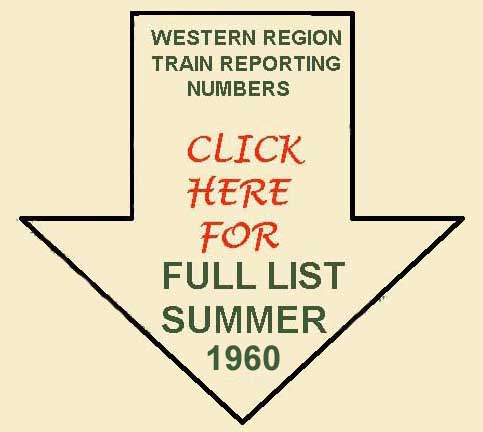 Reading, Didcot, Swindon, Kemble, Chalford, Stroud and Gloucester, where a reversal takes place for the 6½ mile journey to Cheltenham, hauled by a 2-6-2 tank engine. No 5037 had recently been transferred to Old Oak Common (81A) in May 1960 after a six year spell at Worcester shed. Photo is by Norman Preedy.
Reading, Didcot, Swindon, Kemble, Chalford, Stroud and Gloucester, where a reversal takes place for the 6½ mile journey to Cheltenham, hauled by a 2-6-2 tank engine. No 5037 had recently been transferred to Old Oak Common (81A) in May 1960 after a six year spell at Worcester shed. Photo is by Norman Preedy.
(Below) 'Castle' class No 5060 Earl of Berkeley (single chimney) of Old Oak Common speeds through Wellington station, Shropshire with the 2.35pm SO Shrewsbury-Paddington during the Summer of 1960. This loco had a Heavy General overhaul at the end of May 1961 that lasted for 2 months, during which a double chimney was fitted. Nine months later, the loco was withdrawn. I wonder if that effort was considered to be good value for money for the taxpayer! Photo is by DE Canning.


(Above) 'Castle' class No 5094 Tretower Castle had a Heavy General overhaul in May and June 1960, during which a double chimney was fitted. Upon exit from Swindon Works it was assigned to Bath Road shed. In this photo at Goring on Thursday 21 July 1960, 5094 takes train B12, the 1.40pm Paddington to Weston-super-Mare towards Swindon, where the rear portion will be detached and taken on to Gloucester by another engine. (Below) In the opposite direction, Gloucester shed's 'Castle' class No 7035 Ogmore Castle is hauling the 11.45pm Cheltenham Spa to Paddington, due there just after 3pm. It will turn at Ranelagh Bridge depot before backing down to Paddington to take the 4.55pm Cheltenham Spa Express, which was non-stop to Kemble, 91 miles, reaching there at 6.33pm and the onwards to Gloucester at 7.12pm where the rear portion will be taken by a 2-6-2 tank to Cheltenham Spa (St. James) where it terminates at 7.35pm. 

(Above) Another fine picture by the late Jim Davenport, now in the wonderful collection of ex-Manchester railwayman, BKB (Brian) Green. Here 'Castle' class No 5042 Winchester Castle, an Old Oak Common (81A) engine, passes Goring station with train A85, the 1.58pm Weston-super-Mare - Paddington  due there at 5.33pm. No 5042's previous duty was as far as Bristol on the down 'Merchant Venturer'; clear evidence of this turn is the reversed 'Merchant Venturer' headboard fitted high on the smokebox for return to 81A (see inset right). No 5042 was one of the very last Castles to survive until the end of steam on the Western Region.
due there at 5.33pm. No 5042's previous duty was as far as Bristol on the down 'Merchant Venturer'; clear evidence of this turn is the reversed 'Merchant Venturer' headboard fitted high on the smokebox for return to 81A (see inset right). No 5042 was one of the very last Castles to survive until the end of steam on the Western Region.
(Below) Following the transfer of 'Castle' class No 5001 Llandovery Castle from Shrewsbury shed to Old Oak Common at the start of the month, Cedric Owen photographed the locomotive heading the 10.22am SO Paddington-Paignton between Clerk and Parsons tunnels on Saturday 20 August 1960. No 5001 was one of the Castles that acquired box-shaped casings in replacement for the fluted ones when built in 1926. Oddly, in July 1961, just as the diesel age was gathering pace, it acquired a double chimney, but in September 1962 the locomotive was withdrawn from traffic and placed in store. It was reinstated in February 1963 at the height of the bad winter when several diesels were unable to work due to frozen parts, and a number of Castles were brought out of store to help run services.
Introduction of a totally revised system of Reporting Numbers, that became permanent. The new system used a 4 digit code. The first represented the class of train, 1 being express, 2 bring semi-fast, etc. The second digit represented the WR division to which the train was destined, and were 'all Regions wide' to cover for those trains that began or ended on a region other than the Western. For example, holiday trains from the Midlands to south Devon, began life on the Midland Region with a number relevant to that Region, and at Bristol, a new number was applied, and a Western Region loco replaced the Midland Region one. Now the same train number applied throughout its journey. The second digit codes were as follows:
A for trains terminating in the WR London District.
B for trains terminating in the WR Bristol District (including Weymouth)
C00 - C49 for trains terminating in the WR Plymouth District (i.e. Plymouth and Cornwall).
C50 - C99 for trains terminating in the WR Exeter District (i.e. Minehead, and South Devon).
E for destinations in the Eastern Region.
F for trains terminating in the WR Cardiff or Swansea Districts.
H for trains terminating in the WR Birmingham or Worcester District.
J for trains terminating in the WR Chester or Oswestry London District.
M for destinations in the Midland Region.
N for destinations in the North Eastern Region.
O for destinations in the Southern Region.
S for destinations in the Scottish Region.
T for trains terminating in the WR Newport or Gloucester District.
V for trains for destinations in the Western Region that originated in another Region.
Z for internal Western Region excursions and special trains within the Region.
(Below) On 4 June 1960, the Saturday of the Whitsun weekend, 'Castle' class No 5097 Sarum Castle, a Bristol Bath Road (82A) locomotive, heads this extra relief 973, usually a 7.55am Camborne-Bristol train, running Monday and Fridays only, but with a different number today as it is extended to Manchester Central as a relief. BKB Green captures the ensemble heading north from Hereford. 

(Above) On Monday 11 July 1960, 'Britannia' class No 70029 Shooting Star arrives at Paddington with the up 'Capitals United Express', however on this occasion the locomotive has made it no further than the first feet of platform 10. With the tailback of carriages stuck out on the approach line, passengers not only have a long walk to the barriers, any subsequent incoming trains will be affected due to the network of points on the arrival lines being obstructed. Usually, once all passengers have left the train and the empty coaching stock taken away, the loco backs out to be turned at Ranelagh Bridge in readiness for the return to Cardiff on the 3.55 pm down. I don't know what took place here, but if the loco was hauled out to Old oak Common for attention, then the main line standby loco at Ranelagh Bridge, a 'Castle' or a 'Modified Hall', would cover its next duty.
(Below) A popular location for railway photographers is the stretch of line skirting the River Exe estuary between Exeter and Starcross. Passing Powderham Park on Saturday 30 July 1960 is the 12.05 SO Paddington-Plymouth with, as usual, two locos hauling it. On the front is 'Grange' class No 6813 Eastbury Grange of Exeter shed and the train engine is 'Hall' class No 4995 of Easton Hall from Southall shed. No 4995 has probably come the whole way down, with 6813 added at Exeter.

Winter 1960 - 12 September 1960 - 11 June 1961
(Under Construction)
Summer 1961 - 12 June 1961 - 10 September 1961
(Under Construction)
(Below) Prior to its transfer to Llanelly shed (87F) 'Castle' class No 4094 Dynevor Castle of Landore enters Carmarthen station with an express on Thursday 26 May 1961. The chalked M72 on the smokebox door relates to the 11.15am Swansea-Manchester train, which 4094 may have hauled the day before, unless it was suddenly switched to this train for some reason. This is a good example of the perils of trying to interpret just what the Reporting Number on the frame really meant. 


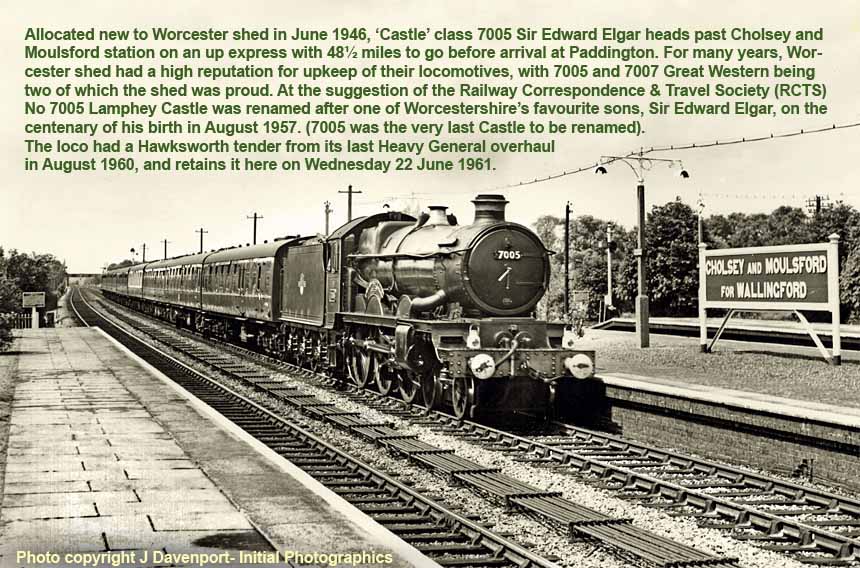

(Above) On Monday 28 August 1961, another case of mistaken identity can be found in this splendid shot of Worcester shed's 'Castle' class No 7004 Eastnor Castle carrying train number A62, which related to its preceding duty, the 11.50am from Hereford, 12.55pm from Worcester, due at Paddington at 3.25pm. Having been turned at Ranelagh Bridge, despite still carrying evidence of its prior run, No 7004 is now returning to the Midlands with the down 'Cathedrals Express'. The train is about to whip through Combe Halt, 71½ miles from Paddington, and 8 miles beyond Oxford on the Oxford, Worcester and Wolverhampton line.
(Below) Following arrival with an express from London, Old Oak Common's 'Castle' class No 4082 Windsor Castle comes to rest at Swansea High Street station on Saturday 15 July 1961. The chalked 'A44' on the smokebox door is wrong; this most likely relates to its previous up working, the 2.30pm ex-Neyland, 5.30pm ex-Swansea, due Paddington 10.10pm the previous day. An interesting exchange of identities occurred in February 1952 when No 4082 was selected to haul the funeral train of King George VI from Paddington to Windsor, but since the locomotive was undergoing repairs at Swindon at that time it was decided to swap the smokebox and cabside numberplates plus the all-important 'Windsor Castle' nameplates with those of No 7013 'Bristol Castle', which then masqueraded as the funeral loco. The plates were never changed back and both locomotives retained their new identities permanently. 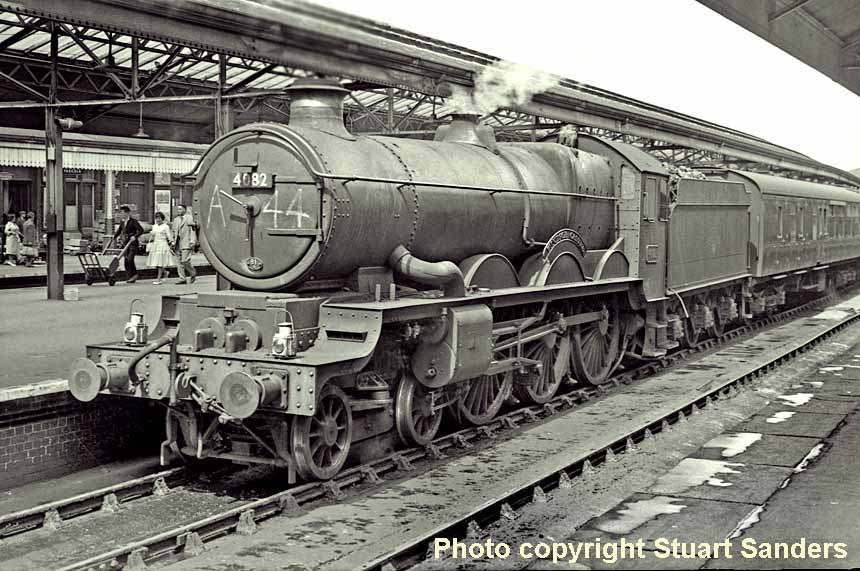

(Above) Another shot of Swansea (High Street) shows 'Hall' class No 4935 Ketley Hall, an 87G Carmarthen engine, at the head of the London-bound 'Pembroke Coast Express' on Saturday 15 July 1961. No 4935 will be the second of three locos to haul this train; the first departed Pembroke Dock at 1.05pm for the initial 40 miles, including ten intermediate stops to Carmarthen, where the train reversed and No 4935 coupled on at the rear. Departing Carmarthen at 2.48pm, the Hall class covered the 30 miles, including one stop at Llanelly as it was then spelt, before arrival at Swansea. Here another reversal took place with one of Landore shed's Class 7P 'Castle' - plus an additional five coaches including a restaurant car - being attached to the rear for the 216 mile run to Paddington. Departing Swansea at 3.45pm, the train now really shifts, attaining an average net speed of 56 mph, including stops at Cardiff (4.53-5.00) and Newport (5.17-5.20) before arrival at Paddington at 7.45pm.
(Below) On Saturday 29 July 1961, Cardiff Canton's 'Hall' class No 7927 Willington Hall hurries train V55, the 0915 SO Blackpool-Cardiff near Wooferton Junction, south of Ludlow on the joint Shrewsbury and Hereford line. No 7927 entered traffic in October 1950 operating from 81D Reading; this was followed by a 2 year spell at Old Oak Common from September 1958 before a move beckoned in September 1960 to its final shed at Cardiff Canton where it survived right up to the end of WR steam. Withdrawn in 1965, No 7927 has since become a source of material for the planned new builds of a 'County' and 'Grange' class locos.
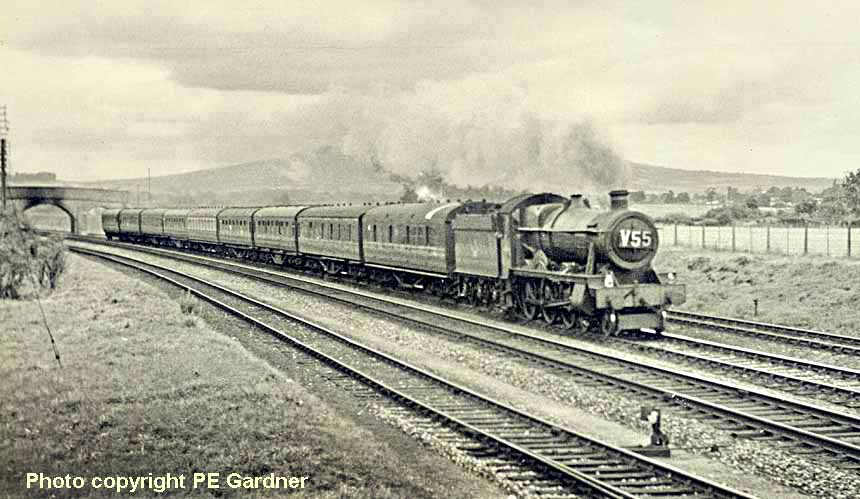
Winter 1961 - 11 September 1961 - 17 June 1962
(Under Construction) 
(Above) A 15mph speed restriction applies for 'Castle' class No 7035 Ogmore Castle on entering Swindon station off the Kemble line; the loco is displaying A09 up 'Cheltenham Spa Express', and shows how the frame SHOULD be fitted; the photo was taken soon after 14 February 1962 when No 7035 returned to traffic at 85B shed after its last Light Intermediate overhaul. The up Cheltenham Spa Express departed Kemble at 9.04am and passed Swindon at 9.20am; this was followed by a fast non-stop run for the 77.3 miles to Paddington in 75 minutes. However 7035's return trip will be less prestigious. I have seen photos of the up CSE loco returning to Swindon on (1) the 10.35am West London (on at West Ealing for a 2.10pm departure) to Whitland milk empties; (2) the 1.40pm combined Paddington-Weston & Cheltenham express, often double-headed ex-Paddington, then taking on the rear portion from Swindon; and (3) the 2.00pm Paddington-Plymouth parcels. Photograph by NE Preedy.
(Below) On Saturday 17 June 1962, the last day of the winter timetable, St Philip's Marsh shed's 'Grange' class No 6811 Cranbourne Grange tackles Wellington Bank with a train that was not in the timetable, the 9.10am Birmingham-Paignton relief. Disappearing on the up side is train 1T30, the 11.08 Plymouth-Cardiff with D804 at its head. Photo is by DJ Frost.
Summer 1962 - 18 June 1962 - 9 September 1962
(Above-Below) A classic shot by Footplate Cameraman Jim Carter of a pair of 'Kings' awaiting their next turn of duty on the turntable stalls at Ranelagh Bridge on 4 September 1962. On the left No 6007 King William III displays train number M20 - the 16.10 Paddington-Birkenhead, loco to Wolverhampton, whilst the frame of 6026 King John shows V04, the up 8.55am Birkenhead-Paddington. (Below) 'Castle' class No 5018 St Mawes Castle of 81D Reading shed brings the 10.50am Wolverhampton-Margate express into Oxford on Thursday 2 August 1962. This is the balancing working of the 9.05am Ramsgate-Wolverhampton, which 5018 probably hauled the day before, and will probably haul again tomorrow. There is a fine gantry to admire with Oxford North Station Signal Box on the right. Ahead and beyond is the gantry at Oxford North Junction, where the old LNWR line to Bicester via Islip diverges for the Port Meadow area. Unseen to the right is the former Rewley Road station which was the LMS terminus for trains on the Bicester line. Photo is by RA Panting.

(Above) Very late in their careers, 'King' class 6005 King George II on train Z11 and No 6000 King George V on train Z1 are waiting to return their race specials non-stop to Paddington from Newbury Race Course station on Saturday 27 October 1962. Both ended their BR lives at Old Oak Common; 6005 had been based at Stafford Road for almost all its life, whereas 6000 sampled several West Country sheds and Bath Road until October 1952 when it settled down at Old Oak Common until its retirement. Photo is by DE Canning
(Above-Insets-Below) Measuring 38½" x 21", a wooden pattern (above) was used by Swindon Works to cast the aluminium headboard for the 'Bristolian'; this beautifully-crafted item went under the hammer for £1100 at a Great Central Railwayana Auction HERE on 11 October 2014. One wonders whether an original wooden pattern  could be used to cast bona fide BR (WR) headboards (as opposed to replicas) of this titled train? (inset right) The finished headboard, complete with painted crests of both London and Bristol was a big improvement over the plain-looking keystone-shaped headboard with Gill Sans lettering.
could be used to cast bona fide BR (WR) headboards (as opposed to replicas) of this titled train? (inset right) The finished headboard, complete with painted crests of both London and Bristol was a big improvement over the plain-looking keystone-shaped headboard with Gill Sans lettering.
An example of the first BR headboard (below) with cream lettering on a chocolate background went under the hammer at a Railwayana UK Ltd Stafford auction HERE on 11th January 2014. Inaugurated in September 1935, the 'Bristolian' title was 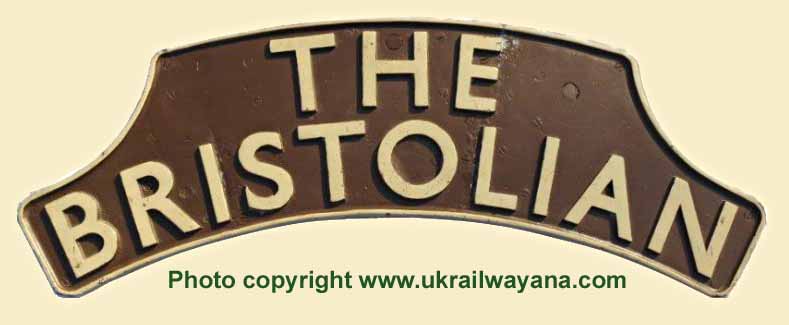 reinstated on 18 June 1951 followed by full reinstatement in June 1954 of an accelerated service with high-speed non-stop runs of 1¾ hours in both directions; the headboard was carried from 1951 as part of the Festival of Britaincelebrations, and in June 1959 the 'Bristolian' went over to diesel haulage with 'Warship' class Type 4 B-B No D800 Sir Brian Robertson in charge.
reinstated on 18 June 1951 followed by full reinstatement in June 1954 of an accelerated service with high-speed non-stop runs of 1¾ hours in both directions; the headboard was carried from 1951 as part of the Festival of Britaincelebrations, and in June 1959 the 'Bristolian' went over to diesel haulage with 'Warship' class Type 4 B-B No D800 Sir Brian Robertson in charge.  (Below) Contrary to appearances, this is not the 'Bristolian'! The titled train ran Mondays to Fridays only, departing Paddington at 8.45am, whereas this train is the 9.05 Mon-Sat from Paddington to Bristol and Weston-super-Mare with stops at Reading, Swindon, Chippenham and Bath. Ben Brooksbank captured 'Castle' class 5015 Kingswear Castle leaving Bath Spa on the final leg of the journey from Paddington to Bristol on Saturday 21 July 1962.
(Below) Contrary to appearances, this is not the 'Bristolian'! The titled train ran Mondays to Fridays only, departing Paddington at 8.45am, whereas this train is the 9.05 Mon-Sat from Paddington to Bristol and Weston-super-Mare with stops at Reading, Swindon, Chippenham and Bath. Ben Brooksbank captured 'Castle' class 5015 Kingswear Castle leaving Bath Spa on the final leg of the journey from Paddington to Bristol on Saturday 21 July 1962.

(Above) Paddington station on Tuesday 28 August 1962 with 'King' class No 6005 King George II about to leave with the 5.10pm to Wolverhampton, next to 'Castle' class No 7031 Cromwell's Castle ready for the 5.15pm departure on the down Cathedrals Express. 7031 shows its previous duty was train A68, the 12.55pm from Worcester that was due here at 3.25pm; 7031 will have reversed to Ranelagh Bridge depot outside the station, where it was turned and watered before backing onto this train. The Cathedrals Express used to be a 4.45pm departure but that was altered to 30 minutes later as from the start of the 1961 Winter timetable on 11 September 1961 and was renumbered T15. The Kings were officially retired at the end of the Summer 1962 timetable on Sunday 9 September, just 12 days after this photograph was taken. But on Thursday 18 October, this King, 6005, did haul the 8.20am Paddington-Shrewsbury (the Inter-City) and returned with the 12.58pm Cambrian Coast Express as far as Snow Hill, where 6011 King James I took over. No 6005 was eventually withdrawn on 19 November, with a final mileage of 1,679,275. No 7031 was at Worcester only for a short time from 24 March 1962 to 16 July 1963, its last day of service, and its mileage since first built and transferred to Laira in June 1950 was 749,715. 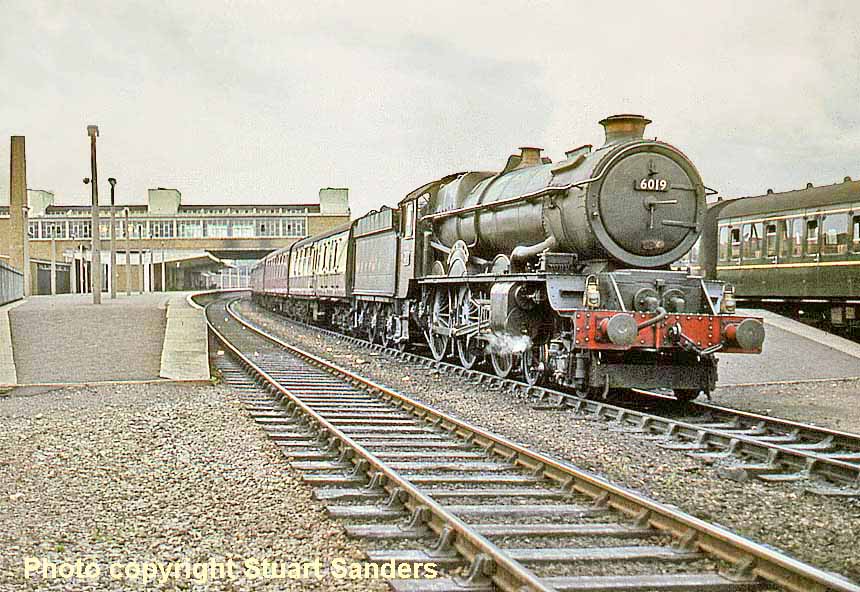
(Above) The fitting of 24-element four-row superheaters and improvements in draughting (double blast pipes and chimneys) enabled the ex-GWR 'Kings' to put in their best performances during their final years. As a result the class did not suffer the indignity of being relegated to menial jobs as happened to the Class 8P Pacifics on other Regions. Despite being in the twilight of its career, No 6019 King Henry V looks in fine fettle at Banbury hauling an up express from Wolverhampton in the summer of 1962; the journey will take about 75 minutes for the 67½ miles via Bicester to London Paddington. Introduced to traffic in July 1928, 6019's wide-ranging shed allocations included Laira (Plymouth), Bath Road (Bristol), Canton (Cardiff), Old Oak Common (London) and Stafford Road (Wolverhampton) shed; this made it possible to clock up a very creditable 1,912,309 miles on all the GWR main lines throughout its 34-year career. However the inevitable withdrawal came at Stafford Road shed on 7 September 1962 and scrapping took place at J Cashmore in Newport in December; indeed the entire 'King' class was withdrawn in 1962, to be replaced by the WR's Diesel Hydraulic 'Western' class locomotives.
(Above) An ex-loco condition nameplate from 'King' Class 4-6-0 No 6019 King Henry V went under the hammer for £26,000 at a Great Central Railwayana Auction in October 2014. No 6019 was named when built at Swindon in July 1928.
(Below) In 1962 the introduction of new Type 4 diesel-hydraulics was already far reaching; by March the 'Warship' series had reached D867, whilst the newly-built 'Westerns' represented another emerging diesel-hydraulic class. Later to become BR Class 52, they had relatively short careers as many were scrapped by the mid to late 1970s. Here D1001 'Western Pathfinder', built at Swindon Works in February 62 and scrapped August 1977 (a lifespan of a mere fifteen years) is seen at Exeter St David's with the SuO 10.20am Plymouth-Paddington in the summer of 1962. In the background is the now-preserved Bulleid 'West Country' class No 34067 Tangmere. The photographer, Barry Hilton, remarks on his page 86: 'At the time I never thought that 34067 would outlive the new diesel classes!'
Winter 1962 - 10 September 1962 - 16 June 1963
(Under Construction)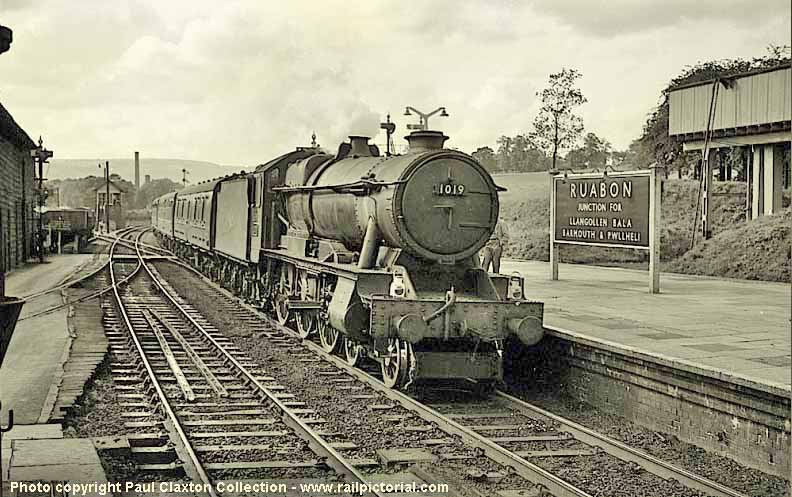
(Above-Below) Rail Cameraman Paul Claxton captured 'County' class No 1019 County of Merioneith arriving at Ruabon with a Paddington-Birkenhead train on Saturday 29 September 1962. Very likely the train departed London Paddington behind a recently built 'Western' D1000 diesel-hydraulic for the 153 miles to Shrewsbury where 1019 was attached for the remaining 57 miles to Birkenhead. Built in April 1946, 1019's first shed was Newton Abbot between 1946 and 1950, during which it was twice swapped between there and Penzance before moving to Shrewsbury in December 1950. Then, perhaps having intrigued enough people as to where Merioneth actually was, the engine was transferred to Stafford Road in 1952 followed by a six-year move to Swindon in February 1954, then to Neyland, and back to Swindon, and finally to its last home shed, Shrewsbury in September 1962. The locomotive acquired a double chimney in March 1959 (one of the last of the class to be fitted); withdrawal came in February 1963. Both photos are reproduced courtesy of Mike Claxton, who has created a superb website in memory of his younger brother Paul, who sadly passed away in April, 2009. Paul's photos are certain to connect with all enthusiasts; a visit here is highly recommended.![]()

Summer 1963 - 17 June 1963 - 9 September 1963
(Under Construction)
(Below) On Saturday 13 July 1963, Oxley shed's 'Grange' class No 6831 Bearley Grange arrives at Banbury with train N63, the 10.34am SO Bournemouth Central-Bradford express. By 1963 the demise of WR steam was gathering pace and, in spite of their unkempt condition, the few remaining locos were used wherever needed. Fortunately for No 6831, just six months after this photograph was taken a Heavy General overhaul beckoned in December, which enabled it to survive many of its contemporaries; the loco remained in service until October 1965. 

(Above) Returning to Banbury a fortnight later, the photographer captures 'Hall', class No 6933 Birtles Hall awaiting departure with train M07, the 11.36am Bournemouth West-Manchester express on Saturday 27 July 1963. Somewhat confusingly, the small board with stencilled numbers '025' continues to be displayed on the top lamp iron from its previous run south whereas the correct reporting number is strung up precariously beneath it. No 6933 was also an 84B Oxley shed engine, however six weeks later the depot was transferred to the London Midland Region and recoded 2B.
(Below) 'Hall' class No 6916 Misterton Hall of Shrewsbury (was 84G, now 89A) is on the 4.55pm Mon-Fri Stourbridge Junction to Worcester semi-fast out of Kidderminster in July 1963. This train normally included a Palethorpe's Pork Sausages van, either a 6 wheeler, or a bogie van as here. Photograph is by GW Sharpe.
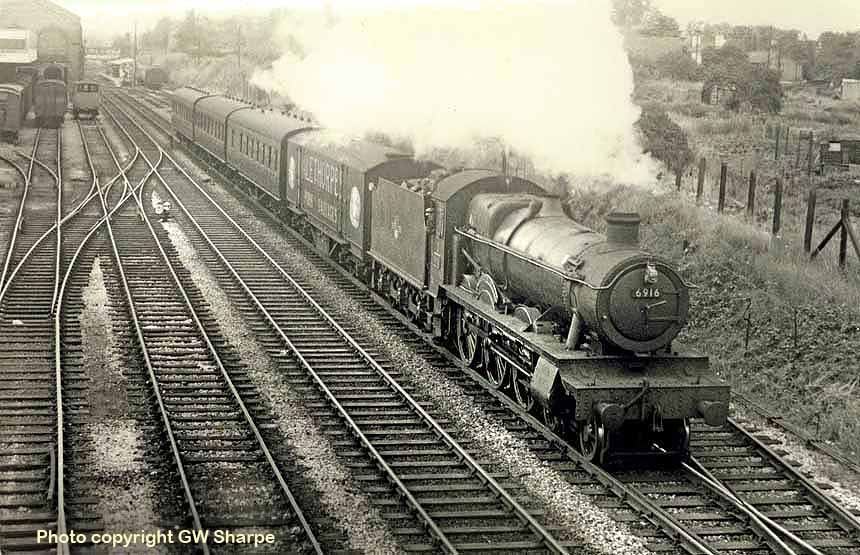
Winter 1963 - 10 September 1963 - 15 June 1964
(Under Construction)
Summer 1964 - 16 June 1964 - 7 September 1964
(Under Construction)
Winter 1964 - 8 September 1964 - 14 June 1965
(Under construction)
My thanks to Rod Blencowe for his generous help in filling the gaps of my own collection. If anyone requires traditional photographic prints of Rod Blencowe's shots, or any other photographic services, Rod's email address is: r.blencowe@ntlworld.com Please note this is not a 'clickable' link via Outlook Express...you will have to email manually.
This page also features photographs supplied by Stewart Blencowe, who has a large archive of black & white postcard-sized photographs of locomotives from both the pre-Grouping and 'Big Four' eras. Many pictures are from his own negative collection and can only be purchased direct from him, either by visiting his interesting website HERE or via railway book fairs, auctions and Open Days; these venues are listed on his website. Stewart has more than forty years of successful trading in all manner of railway items from secondhand books, photos and timetables to ephemera and railway minutia, relics, tape recordings models and miscellania. Postcard size prints can be ordered at £1.50 each including packing and postage.
Stewart's email address is: stewart.blencowe@btopenworld.com - Please note this is not a 'clickable' link via Outlook Express...you will have to email manually
This page also features a number of photographs selected from the superb photographic archive of Initial Photographics - the contact address is: Initial Photographics - Colin Stacey, 25 The Limes, Stony Stratford, Milton Keynes, MK11 1ET.
The Transport Treasury collection of railway photographs is a privately owned archive of images comprising over 300,000 photographic negatives and transparencies of railway, bus, and tram photographs for publishers and enthusiasts. The company produces traditional photographs, hand-printed in a conventional darkroom. The Transport Treasury's huge archive of high-quality original negatives and slides are entrusted to the company by like-minded railway enthusiasts…to visit the website HERE
THIS PAGE IS STILL UNDER CONSTRUCTION. FURTHER TEXT AND PHOTOS WILL BE ADDED IN DUE COURSE..THE FULL CONTENTS OF THE WR HYDRAULIC ERA HAVE NOW BEEN ADDED HERE TO THE BOTTOM OF THE PREVIOUS PAGE
(Inset Right) Mention is made on this site about the superb artwork created by Arthur Nigel Wolstenholme, a freelance technical and commercial artist, who initialled his drawings tantalisingly ANW. Mister Wolstenhome is perhaps most famous for producing crisp, high quality illustrations of steam and diesel locomotives for the covers of Ian Allan's famous abc Locospotter Books.  This original pen and ink drawing of Warship Class diesel hydraulic D801 Vanguard was produced for the BR(W) publicity department. The image measures 8" x 5½" and went under the hammer at a recent Great Central Railwayana Auction.
This original pen and ink drawing of Warship Class diesel hydraulic D801 Vanguard was produced for the BR(W) publicity department. The image measures 8" x 5½" and went under the hammer at a recent Great Central Railwayana Auction.
(Below) Swindon-built D810 Cockade was photographed at Plymouth and shows the clumsy arrangement of the original headcode discs (a legacy of steam days) which didn't sit at all well on the bulbous nose of the D800 class. A new four digit route indicator panel replaced the original discs and number board frames form D813 onwards and these were retro-fitted to D800-D812 at a later date. Although Nos D803-D812 could only work in multiple unit with each other, Nos D803-D870 were eventually fitted with the 'White Diamond' multiple unit coding which enabled them to work in common with the North British D6306-D6357 series B-B Type 2s. The initial specification of Spanner train heating boilers was also changed to Stone-Vapor.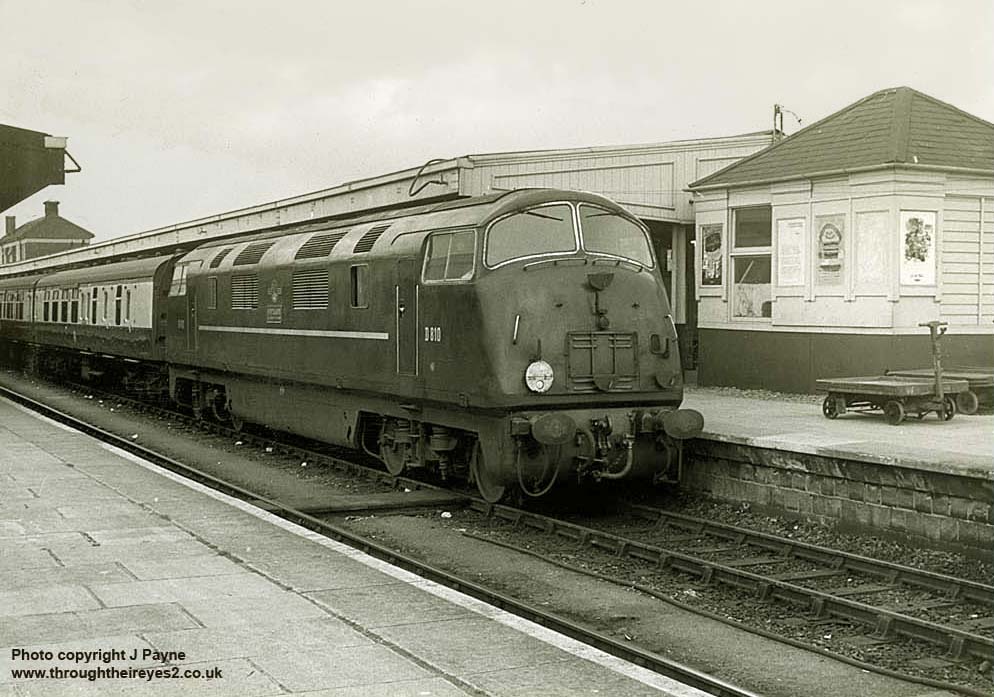
PLEASE NOTE - THIS PAGE IS CURRENTLY UNDER CONSTRUCTION. FURTHER TEXT AND PHOTOS WILL BE ADDED IN DUE COURSE...MEANWHILE THE FULL CONTENT OF THE WR HYDRAULIC ERA HAS BEEN ADDED HERE TO THE BOTTOM OF THE PREVIOUS PAGE
Polite notice: All text and photographs are protected by copyright and reproduction is prohibited without the prior consent of the © owners. If you wish to discuss using any of the contents of this page the email address is below. Please note - this is not a 'clickable' mail-to link via Outlook Express. You will have to email manually.
dheycollection@ntlworld.com




